Travel Through Nepal on a Harley-Davidson
By Peter & Kay Forwood
Nepal on a Harley (27/3/07
- 13/5/07)
Distance 1527 km (490828
km to 492355 km)
This is part of the thirteenth section of our around
the world trip.
Complete Trip Overview & Map
Coming from India or read our previous visit
to Nepal
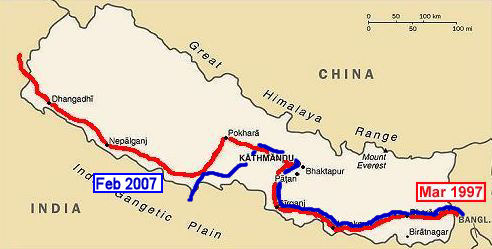 27/3/07 Another warm welcoming from
the Nepalese Authorities but unfortunately they have a strange visa
policy. On a second entry to the country in the same year, they will
only give a 30 day visa, not the normal 60 days, despite us only
having stayed 6 days on our previous visit. This cost $US 30.00, however
if we had stayed a minimum of 15 days previously we would have received
a free 30 day visa? A little awkward as we want to stay longer than
30 days, but if we again leave the country, for at least one night, we
will receive a free 30 day visa on our re-entry, this year. I don't
know who dreams up these complicated visa rules. Customs was easier,
accepting the carnet, even though they are not a signatory to the agreement.
We moved onto Lumbini for the night.
27/3/07 Another warm welcoming from
the Nepalese Authorities but unfortunately they have a strange visa
policy. On a second entry to the country in the same year, they will
only give a 30 day visa, not the normal 60 days, despite us only
having stayed 6 days on our previous visit. This cost $US 30.00, however
if we had stayed a minimum of 15 days previously we would have received
a free 30 day visa? A little awkward as we want to stay longer than
30 days, but if we again leave the country, for at least one night, we
will receive a free 30 day visa on our re-entry, this year. I don't
know who dreams up these complicated visa rules. Customs was easier,
accepting the carnet, even though they are not a signatory to the agreement.
We moved onto Lumbini for the night.
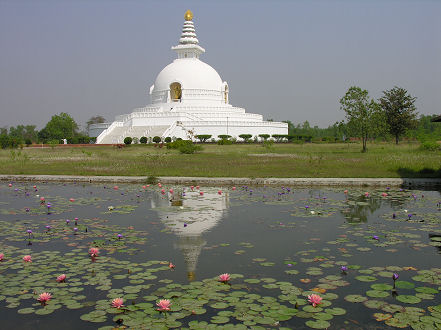 28/3/07 Lumbini is effectively the end of our Buddhist
trail. It was here that Buddha was born about 2500 years ago. A stone,
recently uncovered, is said to mark the exact spot, in the ruins
of a 3rd century BC temple, beside a pond where his mother washed
before she stumbled a few steps and hanging onto the branch of a sal
tree gave birth. A large site of about 3 sq/km has been set aside for
development of international monasteries, stupas, pagodas and temples
to honour the birth. A recent interest has about ten new buildings
under construction from Buddhist societies around the world. Some are
enormous structures like the Japanese World Peace Pagoda or the lavish
German Lotus Stupa, or the Chinese Monastery. We hired a couple of bicycles
to tour the vehicle free grounds, and were again charged a different
fee for foreigners, compared with locals, to enter the site of Buddha's
birth. Amazingly western photos are also somehow different from local's
photos as western cameras are charged five times the local's price.
We voiced our displeasure with this ridiculous two priced situation,
to such an important international site,
28/3/07 Lumbini is effectively the end of our Buddhist
trail. It was here that Buddha was born about 2500 years ago. A stone,
recently uncovered, is said to mark the exact spot, in the ruins
of a 3rd century BC temple, beside a pond where his mother washed
before she stumbled a few steps and hanging onto the branch of a sal
tree gave birth. A large site of about 3 sq/km has been set aside for
development of international monasteries, stupas, pagodas and temples
to honour the birth. A recent interest has about ten new buildings
under construction from Buddhist societies around the world. Some are
enormous structures like the Japanese World Peace Pagoda or the lavish
German Lotus Stupa, or the Chinese Monastery. We hired a couple of bicycles
to tour the vehicle free grounds, and were again charged a different
fee for foreigners, compared with locals, to enter the site of Buddha's
birth. Amazingly western photos are also somehow different from local's
photos as western cameras are charged five times the local's price.
We voiced our displeasure with this ridiculous two priced situation,
to such an important international site,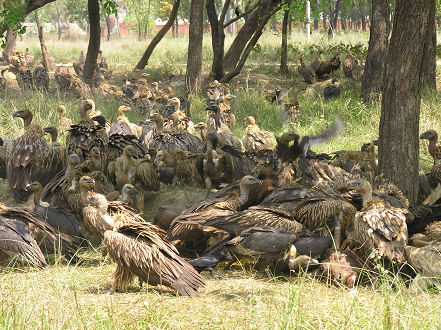 where almost all development
money has come from foreign donors, only to be insulted by being
charged a discriminatory entrance fee, to little effect, to an uncaring
official who had obviously had many similar such complaints. An
interesting aside was watching about a hundred vultures compete with
half a dozen dogs for the carcass of a recently dead steer. The remains
were stripped bare within an hour of our watching, leaving only the
skeleton. It is a jailable offence to kill a cow in the Hindu Nepalese
society. Cows are kept for milking and breeding, some steers are used
in the fields or for carting goods but there is often a surplus. Water buffalo's are different, making it to restaurant menu's,
and are often the preferred work animal on farms. The dead steer had been skinned and it's ears removed making
any identification impossible.
where almost all development
money has come from foreign donors, only to be insulted by being
charged a discriminatory entrance fee, to little effect, to an uncaring
official who had obviously had many similar such complaints. An
interesting aside was watching about a hundred vultures compete with
half a dozen dogs for the carcass of a recently dead steer. The remains
were stripped bare within an hour of our watching, leaving only the
skeleton. It is a jailable offence to kill a cow in the Hindu Nepalese
society. Cows are kept for milking and breeding, some steers are used
in the fields or for carting goods but there is often a surplus. Water buffalo's are different, making it to restaurant menu's,
and are often the preferred work animal on farms. The dead steer had been skinned and it's ears removed making
any identification impossible.
29/3/07 Hinduism is an ancient religion, believed to be
more than 3500 years old and has changed to meet different needs
at different times. The one "God" has three main physical "other
God" representations, Brahman, Shiva and Vishnu. Vishnu has ten
incarnations, deities of earthly form, of which Buddha was incorporated
as one form. Shiva has over 1000 manifestations,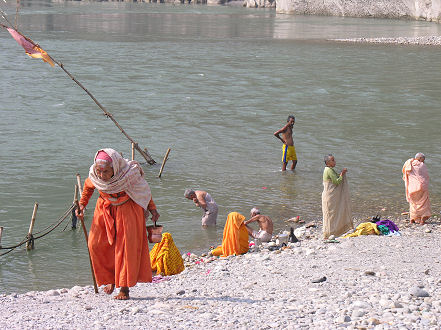 how he shows himself. Added to these there can be an
associated animal, monkey, bull, and consorts. There are temples
in every small town and almost every temple shows a different form
or manifestation that is worshiped. It is a complicated religion to understand
and follow. Hinduism is taken very seriously in Nepal and moreso at
Devghat. Here two rivers meet, later flowing into the Ganges River in
India, and many feel this is the most sacred place for Hindu's to die
in Nepal. Old people congregate, bathe daily at the rivers confluence, waiting
out the last years of their lives, and will be cremated at this confluence.
A quiet, vehicle free town, accessed only by a long pedestrian suspension
bridge across one of the rivers, we walked to the confluence this morning
and quietly watched as the elderly ritually bathed and threw offerings
of petals into the waters. Rode on to Chitwan National Park later in the
day.
how he shows himself. Added to these there can be an
associated animal, monkey, bull, and consorts. There are temples
in every small town and almost every temple shows a different form
or manifestation that is worshiped. It is a complicated religion to understand
and follow. Hinduism is taken very seriously in Nepal and moreso at
Devghat. Here two rivers meet, later flowing into the Ganges River in
India, and many feel this is the most sacred place for Hindu's to die
in Nepal. Old people congregate, bathe daily at the rivers confluence, waiting
out the last years of their lives, and will be cremated at this confluence.
A quiet, vehicle free town, accessed only by a long pedestrian suspension
bridge across one of the rivers, we walked to the confluence this morning
and quietly watched as the elderly ritually bathed and threw offerings
of petals into the waters. Rode on to Chitwan National Park later in the
day.
30/3/07 With the warmer weather the tourists numbers have
thinned. We are here for peace and quiet and took a comfortable
room riverside, incredibly priced at $US 6.00 a night. Sauraha,
the park's support town, has suffered economically from the fighting
in Nepal, not only from a decrease in tourists but also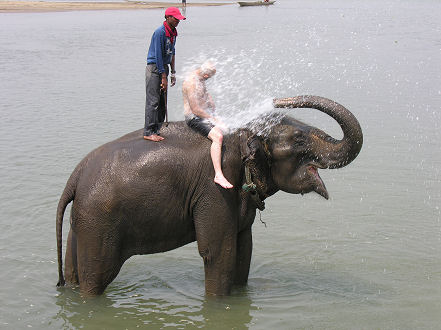 from reduced animal numbers in the park due to poaching,
whilst the governments attentions have been elsewhere. Nepali tourists
have increased recently as travel within their own country has become
safer. There are still enough visitors to demand elephant rides, and
the elephants need bathing, which happens in the river each day outside
our hotel. About eight elephants, with mahouts, arrived after the morning's
rides. Anyone, for the price of a donation, can help wash the elephants,
getting to ride them into the water and getting a shower from it's trunk.
A relaxed fun time for the elephants they seem to enjoy the excitement,
screams and laughing as the tourists get drenched.
from reduced animal numbers in the park due to poaching,
whilst the governments attentions have been elsewhere. Nepali tourists
have increased recently as travel within their own country has become
safer. There are still enough visitors to demand elephant rides, and
the elephants need bathing, which happens in the river each day outside
our hotel. About eight elephants, with mahouts, arrived after the morning's
rides. Anyone, for the price of a donation, can help wash the elephants,
getting to ride them into the water and getting a shower from it's trunk.
A relaxed fun time for the elephants they seem to enjoy the excitement,
screams and laughing as the tourists get drenched.
31/3/07 We had come here to rest up and actively did that
today. Hardly leaving our hotel room, except for meals and a little
bit of maintenance on the motorcycle we processed photos, an ongoing
job as we like to caption each photo, now many more with digital cameras.
1/4/07 Kay decided she would like a bath with the elephants
this morning and choosing one of the five resting in the river she
found it to be a little more playful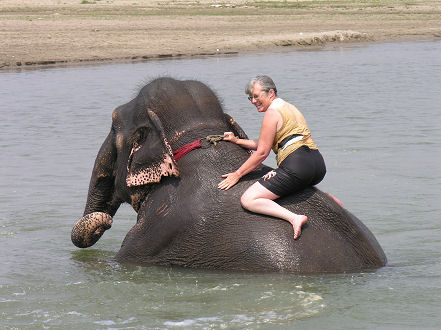 than anticipated. A young five year old, the elephant
was enjoying lying in the current and was not too excited about giving
a tourist a ride. Despite much encouragement from it's mahout, the elephant,
each time Kay tried to climb aboard, decided to bury it's head under
the water and roll over to one side, dislodging Kay. It rose onto it's
front legs a few times, with Kay aboard, but left it's rear end on the
river bed, to the great humour of Kay and the mahout. The young elephant
seemed to be more playful than wilful in it's antics.
than anticipated. A young five year old, the elephant
was enjoying lying in the current and was not too excited about giving
a tourist a ride. Despite much encouragement from it's mahout, the elephant,
each time Kay tried to climb aboard, decided to bury it's head under
the water and roll over to one side, dislodging Kay. It rose onto it's
front legs a few times, with Kay aboard, but left it's rear end on the
river bed, to the great humour of Kay and the mahout. The young elephant
seemed to be more playful than wilful in it's antics.
2/4/07 There are a number of community forests bordering
the national park. Animals can wander freely between the areas
but many stay in the more protected community forests, away from
predators and poachers. The community has it's own rangers, watching
animals and clearing weeds and undergrowth so tourists can view clearly.
Almost thirty privately owned elephants use these community lands for
animal watching rides. There is also a watch tower in one where we stayed
the night. Walking to the tower in late afternoon we came across four
rhino. The first two, a mum and small calf, are quite tame, living in
the same place and being viewed by elephant riding tourists every day.
The other two were more serious and our guide,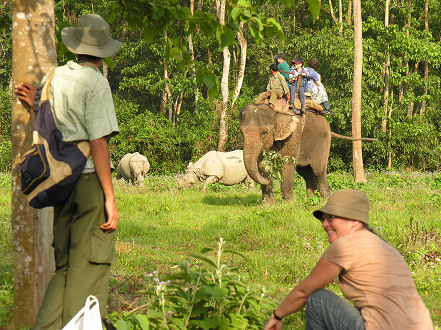 still wearing bandages from a rhino attack three weeks
ago, was extremely cautious. To get to the tower we needed to be
shepherded, elephants between us and the rhino, so as not to disturb
them. The tower has views over a cleared part of the forest where deer
and pigs come down to graze. On dusk we went for another walk, this time
coming across a rhino wallowing in a drying up pool. A little disturbed
by our sudden appearance he rose as if to give chase which was enough
to have us moving quickly away. Rhino are short sighted and have poor
hearing which means they can be approached quite closely but have a reputation
for aggression, charging at anything. The night passed in the watchtower
with only jungle sounds and a few distant town dogs.
still wearing bandages from a rhino attack three weeks
ago, was extremely cautious. To get to the tower we needed to be
shepherded, elephants between us and the rhino, so as not to disturb
them. The tower has views over a cleared part of the forest where deer
and pigs come down to graze. On dusk we went for another walk, this time
coming across a rhino wallowing in a drying up pool. A little disturbed
by our sudden appearance he rose as if to give chase which was enough
to have us moving quickly away. Rhino are short sighted and have poor
hearing which means they can be approached quite closely but have a reputation
for aggression, charging at anything. The night passed in the watchtower
with only jungle sounds and a few distant town dogs.
3/4/07 An early start walking back to town, breakfast
and off riding into the mountains towards Kathmandu. The motorcycle again
overheating as we climbed up from Hetauda. Stopped roadside to let it cool
and decided we need to investigate the problem further as it is likely damaging
the newly built engine. With the lap top, literally on our lap, sitting by
the roadside, while the motorcycle cooled, checking the workshop manual,
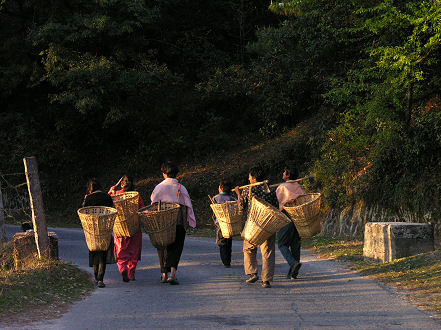 we surmised the oil pump as the likely problem.
It seems there is leakage somewhere and when the oil is hot and thin
insufficient pressure can be obtained and the engine runs hot. We continued
on to Daman at the top of the mountain range, where an old run down two
storied stone building was our accommodation. The first floor wooden balcony
barely supported our weight and the rammed earthen floor was ripply from
sagging beams. It was quaint and comfortable and we were left alone, the
building to ourselves for the day, the owner returning in the evening.
we surmised the oil pump as the likely problem.
It seems there is leakage somewhere and when the oil is hot and thin
insufficient pressure can be obtained and the engine runs hot. We continued
on to Daman at the top of the mountain range, where an old run down two
storied stone building was our accommodation. The first floor wooden balcony
barely supported our weight and the rammed earthen floor was ripply from
sagging beams. It was quaint and comfortable and we were left alone, the
building to ourselves for the day, the owner returning in the evening.
4/4/07 The view from here to Mount Everest, less than 200km
away, is supposed to be one of the best in Nepal, however the skies need
to be clear and even though we were up with the sun the smoky haze prevented
the mountain's appearance. We did see the peaks of some closer snow-caps
above the smog on our walk to the viewing spot. A peaceful trail through
a flowering rhododendron forest to a small flag draped Buddhist gompa
was disturbed on its return by four busloads of Nepalis from Kathmandu
on a pilgrimage to the same gompa. Excited by their adventure the loud
voices echoed through the quiet hillside. In the afternoon we had the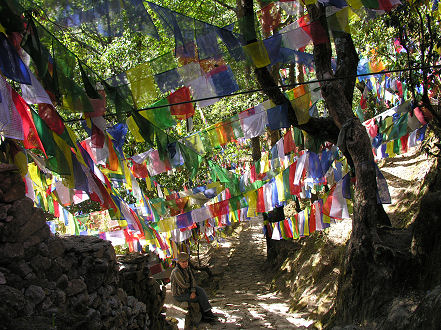 oil pump off the motorcycle. A question often asked is
can we fix everything on the motorcycle. The answer, only things
that have previously broken. As the oil pump has not previously needed
repairs we were opening it for the first time. An oil seal looks to
have hardened and along with scoring to the pump wall, likely done when
we had a cam follower collapse in Russia two years ago, it seems the
oil pump could be the likely oil pressure culprit.
oil pump off the motorcycle. A question often asked is
can we fix everything on the motorcycle. The answer, only things
that have previously broken. As the oil pump has not previously needed
repairs we were opening it for the first time. An oil seal looks to
have hardened and along with scoring to the pump wall, likely done when
we had a cam follower collapse in Russia two years ago, it seems the
oil pump could be the likely oil pressure culprit.
5/4/07 The pump was reassembled, an O-ring placed on the
shaft near the seal to hopefully stop oil loss between chambers and
we headed off towards Kathmandu. If we had made any improvement in
the pump at all, it was not very apparent, as heading up the last 20km
to the city and getting stuck in a traffic jam, again we had the oil
light coming on from heat and low pressure. Kathmandu has become a tourist
mecca since we were here two months ago. It doesn't seem like the same
place. Thousands of tourists, almost outnumbering locals in areas like
Thamel, the main centre, are here. Accommodation discounts have disappeared
and the number of hardened street sellers tripled.
6/4/07 Off to the Indian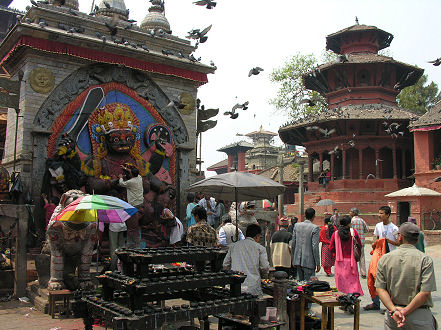 Embassy this morning, early. We had been warned of long
lines and slow processing so at 6am we were at the gates only to be
told the embassy was closed for the Easter holiday. Easter holiday
in Nepal, a Hindu country? Easter holiday at the Indian Embassy? We emailed
our son and the Harley dealer in Australia, Morgan and Wackers, to see
if they had an oil pump in stock, and hopefully will have it sent to Kathmandu.
Kathmandu is modern enough, or receives enough tourists, that it has a
couple of wifi, wireless internet connection points, a first for us, and
we used the lap top to surf the net while sitting in a comfortable restaurant
most of the afternoon and evening, enjoying drinks and a meal and conversation.
Embassy this morning, early. We had been warned of long
lines and slow processing so at 6am we were at the gates only to be
told the embassy was closed for the Easter holiday. Easter holiday
in Nepal, a Hindu country? Easter holiday at the Indian Embassy? We emailed
our son and the Harley dealer in Australia, Morgan and Wackers, to see
if they had an oil pump in stock, and hopefully will have it sent to Kathmandu.
Kathmandu is modern enough, or receives enough tourists, that it has a
couple of wifi, wireless internet connection points, a first for us, and
we used the lap top to surf the net while sitting in a comfortable restaurant
most of the afternoon and evening, enjoying drinks and a meal and conversation.
7/4/07 Durbar Square is the still functioning centre of
Old Kathmandu and probably it's most visited tourist attraction.
There is a plethora of religious shrines here dating back to the 13th
century, and likely earlier, and most are still worshipped at
today, and everyday. Early morning Hindus perform Puja, the bringing
of a plate, mostly flowers and grains, or burning a butter candle,
to their favourite deity. There is one for almost all ailments. To help
cure or prevent, small pox, leprosy, poor sight, eradicate demons,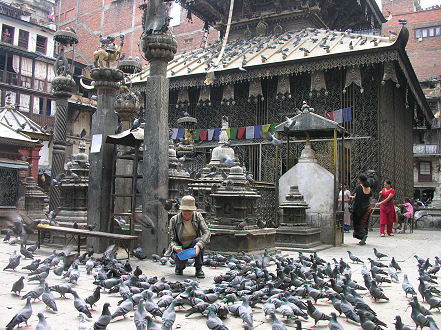 for fertility, rain making, making money, and even a large piece
of wood, where if a coin is nailed into it, it is supposed to cure toothache.
And just in case that doesn't cure the toothache, there are plenty
of western style dentists in the area. We wandered, sat and watched
the faithful go through their morning rituals and incantations before
their preferred deity, wondering if the west is vastly different with
it's array of saints and high church rites. The food offerings are removed
by the thousands of pigeons and a few fat cows that benefit from the generosity.
for fertility, rain making, making money, and even a large piece
of wood, where if a coin is nailed into it, it is supposed to cure toothache.
And just in case that doesn't cure the toothache, there are plenty
of western style dentists in the area. We wandered, sat and watched
the faithful go through their morning rituals and incantations before
their preferred deity, wondering if the west is vastly different with
it's array of saints and high church rites. The food offerings are removed
by the thousands of pigeons and a few fat cows that benefit from the generosity.
8/4/07 Swayambhunath or the Monkey Temple, set on a hilltop
overlooking the city was originally a Buddhist centre but today
with Buddhism incorporated into the Hindu religion it is visited
by more Hindu faithfuls than Buddhists. A long stairway leads up to
the large stupa and it's surrounding temples, where dozens of fat
monkeys collect the offerings to the gods made by the faithful. Another
place to people watch, both tourists and locals. If the world stopped
watching each other or being interested in each other's lives little
would be learnt, but more would be done. Unlike at Durbar Square the souvenir
sellers here have learnt that 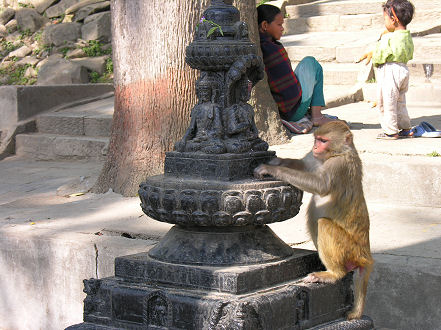 tourists don't want to be pestered by them. They seem to understand
tourists like to shop unpressured, and will ultimately buy more. Kathmandu
is one of the world's hardest sell places, from cycle rickshaws to tatty
dressed women with babies at hip begging, they interrupt to get attention,
cut people off by walking or standing in front of them, tug onto their
shirt sleeve, refuse to take no for an answer, even if it is repeated
many times. It is the burden of the haves and the weapon of the have
nots, guilt, a weapon that works well with polite new western tourists
who have often seen poverty on television and are now fronted with it
for the first time. In all our travels we have not found a universal way
to easily and politely deter beggars and touts. We have tried to ignore
them, say no once, repeat the no, occasionally raise our voice, shrug our
shoulders, look them in the eye, avoid eye contact, but they are experts
at their job and often have the added incentive that comes with hunger,
their persistence levels can be greater than most people's tolerance levels.
What really amazes me is do they feel by pestering more, people are more
likely to give a donation, buy from them, or use their services, when
by the time they have become annoying they are
tourists don't want to be pestered by them. They seem to understand
tourists like to shop unpressured, and will ultimately buy more. Kathmandu
is one of the world's hardest sell places, from cycle rickshaws to tatty
dressed women with babies at hip begging, they interrupt to get attention,
cut people off by walking or standing in front of them, tug onto their
shirt sleeve, refuse to take no for an answer, even if it is repeated
many times. It is the burden of the haves and the weapon of the have
nots, guilt, a weapon that works well with polite new western tourists
who have often seen poverty on television and are now fronted with it
for the first time. In all our travels we have not found a universal way
to easily and politely deter beggars and touts. We have tried to ignore
them, say no once, repeat the no, occasionally raise our voice, shrug our
shoulders, look them in the eye, avoid eye contact, but they are experts
at their job and often have the added incentive that comes with hunger,
their persistence levels can be greater than most people's tolerance levels.
What really amazes me is do they feel by pestering more, people are more
likely to give a donation, buy from them, or use their services, when
by the time they have become annoying they are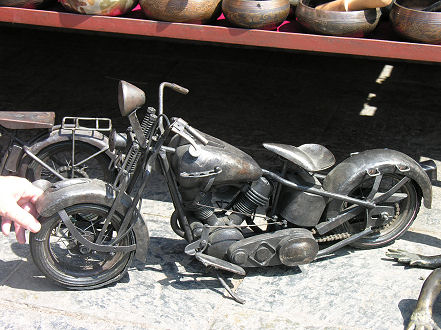 likely the last person most people would think of dealing with.
This also is their power. A beggar can annoy someone far beyond what
would be tolerated from anyone else. Few would side with a foreigner
who raises his voice, or threatens a local beggar, no matter how obnoxious
or rude they became.
likely the last person most people would think of dealing with.
This also is their power. A beggar can annoy someone far beyond what
would be tolerated from anyone else. Few would side with a foreigner
who raises his voice, or threatens a local beggar, no matter how obnoxious
or rude they became.
9/4/07 Our Indian visa expires before we will be leaving
the region. We were again at the embassy early but it was near 1pm
before we had seen an official. A couple of hundred foreigners were
being processed before us by the two Indian agents allocated to the
task. Before anyone can even apply it is necessary for the embassy
here to telex the Indian Embassy in your home country, for permission
for this embassy to issue the visa. It took the morning waiting for
our turn to fill in the form and pay the telex fee. If they have received
an answer to the telex, in three day's time, we can again line up and
submit the visa application, which could be processed the same day. An
American who had waited a week was submitting another telex, no reply to
the first one. This process is the improved version. Our guide book talks
of the previous system where people started lining up at 4am as there were
a limited number of applications 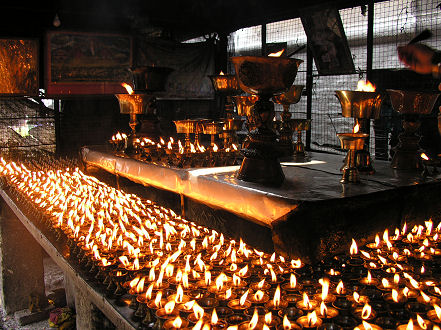 seen each day, and a surplus of applicants.
seen each day, and a surplus of applicants.
10/4/07 Another visa run. This time to the Pakistan Embassy.
A little more personal and immediate than yesterday's wait. Pakistan
requires a letter from the applicant's embassy, due to tension in the
country, and the Australian Embassy here issued ours on the spot. Collect
the visa in two day's time. Nepal has some great rafting rivers. We canvassed
a couple of tour operators and settled on a four day kayaking course and
a ten day raft trip two weeks later. Whilst tourist numbers are up 30%
on last year they are coming off a low base and many tour operators still
aren't getting enough people to run tours.
11/4/07 Bodhnath is where many Tibetan refugees settled
after fleeing Chinese communists in the late 1950's. Since then a
number of monasteries have been built in the area surrounding the main
stupa which dates back over a thousand years. We listened to the cymbal
clanging, drum banging, trumpet blowing and chanting typical to a Tibetan
gompa. Later in the day we walked to the main Hindu burial cremation
ghats and holy site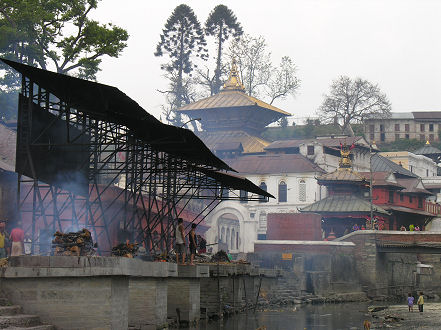 at Pashupatinath where like in India people are cremated on an
open wood fire, their ashes then washed into the sacred river.
at Pashupatinath where like in India people are cremated on an
open wood fire, their ashes then washed into the sacred river.
12/4/07 Almost all of Nepal's taxis are small Suzuki,
800cc models. Petrol is by far their major expense and a careful driver can
save more than his daily wages in petrol. Just 2-3 litres is a day's pay.
This results in a different driving style as the engine is turned off at
the shortest stopping of traffic. The neutral gear is engaged to let the
car roll on any downhill and running in a higher gear than normal are all
methods the drivers use. Empty taxis rarely drive past looking for a fare
and passengers need to seek out where they are parked. We caught a taxi back
to the Indian Embassy after easily collecting our Pakistan visa. Unfortunately
no reply had been received to the telex for my Indian visa application. Kay
could have a multiple entry visa, her telex was answered, but I could only
have a double entry visa. As we need three entries another telex had to be
sent to Australia, a reminder to that Indian Embassy that we need a reply.
The general comment from others waiting, "This Is India", which seems to
explain away any lack of efficiency, logic or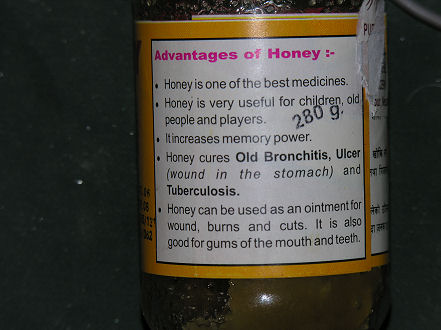 reasoning as to how things happen, or don't happen in India. We
can return again, line up again, mid next week, to see if the Indian
Embassy in Australia has replied to the telex. I have had sore gums for
the last couple of months and decide to see a dentist. The one recommended
by a western hotel was basic. The dentist advising me that there are no
regulations relating to dentists in Nepal and that most are staffed by,
at best, a technician, not a qualified dentist. Looking further into a
country of few regulations we read the label of a jar of honey which purports
to cure anything from bronchitis to tuberculosis. It can increase memory
power and is useful for "players"?
reasoning as to how things happen, or don't happen in India. We
can return again, line up again, mid next week, to see if the Indian
Embassy in Australia has replied to the telex. I have had sore gums for
the last couple of months and decide to see a dentist. The one recommended
by a western hotel was basic. The dentist advising me that there are no
regulations relating to dentists in Nepal and that most are staffed by,
at best, a technician, not a qualified dentist. Looking further into a
country of few regulations we read the label of a jar of honey which purports
to cure anything from bronchitis to tuberculosis. It can increase memory
power and is useful for "players"?
13/4/07 Different countries have different new year dates
and Nepal's is April 14th making today New Year's Eve. The country has
a festive feel. People after ten years of fighting have started to realise
they can move about their own country freely, without fear and can again
enjoy life. Many places have been attracting more local tourists than
internationals after the Maoists were recently incorporated into the government.
Thamel, normally the international tourist centre in Kathmandu was tonight
given over to young local men, some young women, for New Year celebrations.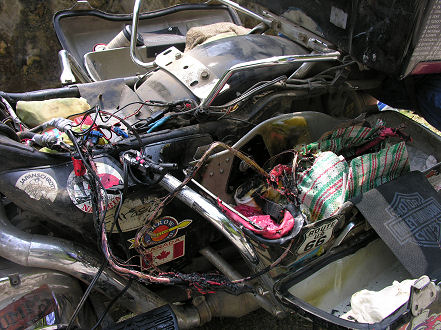 Western boom boom dance music penetrated every hotel room and
we almost slept, with earplugs.
Western boom boom dance music penetrated every hotel room and
we almost slept, with earplugs.
14/4/07 The roads out of Kathmandu were packed with holiday
makers. Not many private cars, petrol is too expensive, but bus loads
of holiday celebrators heading for rural riverside spots and dozens of
motorcyclists carried their girlfriends for an outing. We headed towards
the Chinese border to the north when the motorcycle stopped running. On
pulling over a fire was burning under the seat. It then erupted inside
the left pannier, luckily in its early stages, we doused it with our drinking
water but not before it had singed a number of pannier contents. We carry
the motorcycle's battery in the pannier as genuine HD batteries are not
usually available, those batteries that are available are too large to fit
in the allocated spot. The positive lead, running under the seat, had shorted
to the frame and totally melted all it's coating rubber, catching fire,
and finally melting through the copper cable. Our concern was what damage
had it done to the motorcycle's electrics or the battery. Amazingly when
we had cleaned up the mess and reconnected the battery it started the motorcycle.
Covering the now bare cables with inner tube strips and electrical tape
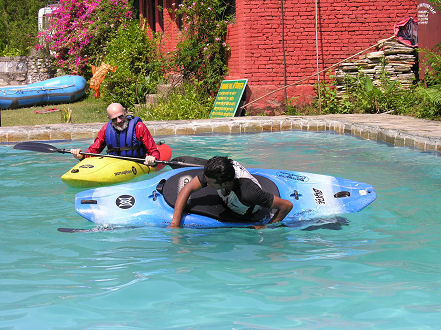 had us continuing into the mountains.
had us continuing into the mountains.
15/4/07 The Bhote Kosi river is one of Nepal's favourite
short trip river rafting rivers. We are at a tented campsite riverside
where I am to learn kayaking while Kay was here to relax but the operators
offered for us both to join today's rafting trip. So after an hour in
the pool with the kayak, practising paddling, rescues and rollovers we
headed for the river rafting. The river is currently low, relying only
on snow melt for volume as the monsoon rains don't arrive till June. We
have both rafted before, many years ago, and mixed in with the younger crowd
of travellers. The low river made the going easy with a few exciting rapids,
where Kay managed to get flicked out of the raft near the top of the biggest
one. Falling backwards and caught underneath the raft for a few seconds
she surfaced confused and continued to bob, carried with the fast current,
till a rescue kayaker pushed her towards the raft for an unceremonious
rejoining whilst we were still manoeuvring through the long set of rapids.
Whilst one other passenger had been flipped out during the day Kay's was
the most spectacular and warranted great conversation over dinner as all
the rafters stay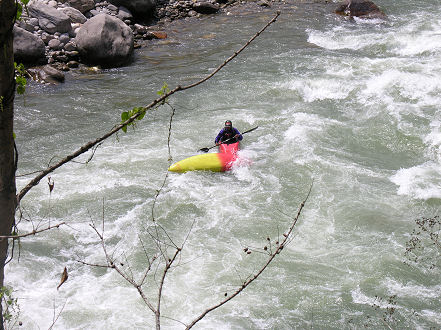 the night at the camp and hit a more difficult section of the
river tomorrow.
the night at the camp and hit a more difficult section of the
river tomorrow.
16/4/07 Kay had again been invited to join the rafters
but had wrenched her hand a bit yesterday and it was swollen and quite
sore. It was necessary for me to get seriously into the kayaking course.
Another session in the pool with a number of eskimo roll attempts and
a few successes before we hit the river. I am the only student, receiving
one on one instruction, which is great, but a bit "full on" as there is
little rest between lessons. A couple of practice rolls in the river and
an unplanned self rescue where being caught upside down, it was necessary
to escape the kayak. The afternoon had us down river, popping through
small white water where again I went over and ended up drifting for half
a kilometre before the river was quiet enough to escape to the bank. We
caught a public bus, kayak and us riding on the roof, during a thunderstorm,
back to the campground. The day and I were finished by 3pm. Totally exhausted
I was wondering if mid fifties was a little bit late to be learning to kayak
for the first time.
17/4/07 A pool session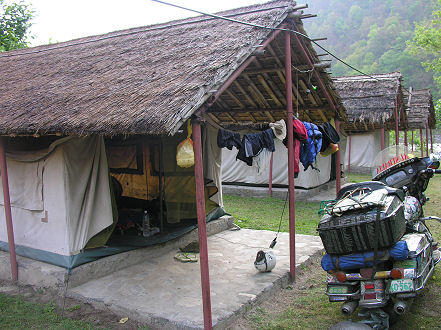 with more successful eskimo rolls and feeling comfortable we again
hit the lower river, travelling six km's. There are no rafters or kayakers
here today so the riverside is ours alone. A few more practice eskimo
rolls in the swirling river waters and a few hard paddling exercises. Flipped
over accidentally in one rapid and after unsuccessfully trying to roll
back upright on my own I needed a T-rescue. Whilst drifting upside down
the instructor places his kayak in a position for me to use it as leverage
to roll upright. Much better than a self rescue, which involves leaving
the kayak and bobbing in the rapids. Being the only student progress moves
at my energy levels so we had this afternoon off, enjoying the riverside
camp.
with more successful eskimo rolls and feeling comfortable we again
hit the lower river, travelling six km's. There are no rafters or kayakers
here today so the riverside is ours alone. A few more practice eskimo
rolls in the swirling river waters and a few hard paddling exercises. Flipped
over accidentally in one rapid and after unsuccessfully trying to roll
back upright on my own I needed a T-rescue. Whilst drifting upside down
the instructor places his kayak in a position for me to use it as leverage
to roll upright. Much better than a self rescue, which involves leaving
the kayak and bobbing in the rapids. Being the only student progress moves
at my energy levels so we had this afternoon off, enjoying the riverside
camp.
18/4/07 The last day and effectively the exam. A three
km stretch upriver with one grade three rapid, three grade two and four
ungraded, but for beginners, still difficult whitewater. The first two
rapids went well and we walked to look at the grade three to select a line.
Almost through and I caught a wave sideways and was over, an attempted
unsuccessful roll and I was again swimming having escaped the kayak. Two
rapids later and again I was upside down but this time the eskimo roll
worked,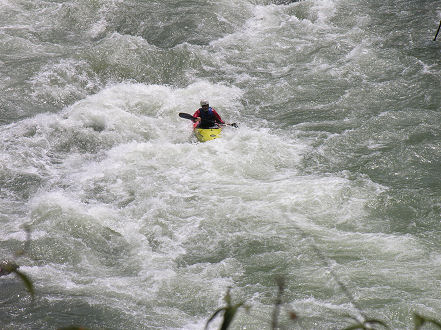 on the second attempt, and we finished without further adrenaline.
Less than two hours on the river this morning and again I was exhausted
but pleased with the results. A celebratory couple of cold beers in the
evening rounded off our stay here.
on the second attempt, and we finished without further adrenaline.
Less than two hours on the river this morning and again I was exhausted
but pleased with the results. A celebratory couple of cold beers in the
evening rounded off our stay here.
19/4/07 Back to Kathmandu and straight to the lines at
the Indian Embassy in the morning where we were promised multiple entry
visas and collected them late afternoon. The new oil pump, sent by our
son from Australia, was at the hotel when we arrived along with gaskets
and seals. While surfing the internet at another hotel, Tracy, who I used
to work with in our home town in Australia 15 years ago, recognised us and
with her partner, Steve, we went out to dinner at a rooftop restaurant. It
is only the second time, while we have been travelling, that we have met
someone we knew from our home town.
20/4/07 Early start to fit the new oil pump in the hotel
parking lot. We also had the cam area apart to fit new breather gear,
also damaged by pieces of metal from the lifter collapse in Russia two
years ago. The job seemed to go well and we found some fluff material in
the old pump that might have been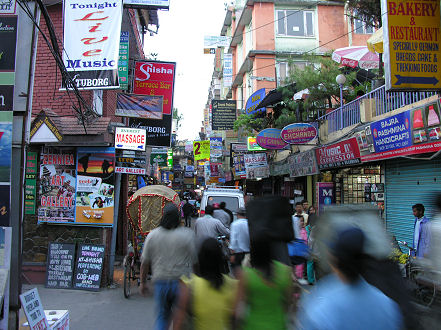 partially blocking one of the oil lines but a new pump at almost half
a million km's is probably necessary. We won't know if this solves the
low oil pressure problem until the motorcycle is run for a couple of hours,
tomorrow. We joined Tracy and Steve again for dinner. They are here for
a trek to Everest Base Camp, starting tomorrow and spent the day looking
around Kathmandu's sights.
partially blocking one of the oil lines but a new pump at almost half
a million km's is probably necessary. We won't know if this solves the
low oil pressure problem until the motorcycle is run for a couple of hours,
tomorrow. We joined Tracy and Steve again for dinner. They are here for
a trek to Everest Base Camp, starting tomorrow and spent the day looking
around Kathmandu's sights.
21/4/07 Left Kathmandu for Pokhara. The traffic still slow
and petrol is again not available due to a transport strike. Luckily we
bought some two days ago. The new oil pump doesn't seem to be overcoming
the low oil pressure problem when the motorcycle is hot. The pressure
is slightly better but only due to lack of wear in the new unit, so it
appears the pump has not been the cause of the problem.
22/4/07 Pokhara is situated next to a lake flanked by a
snow-capped mountain range nearby where trekkers head into the Annapurnas.
Lakeside has grown enormously in the last ten years with restaurants,
bars, kayaking, rafting and paragliding adding to the trekking entertainment.
Almost traffic free compared to Kathmandu it is a relaxed quiet place.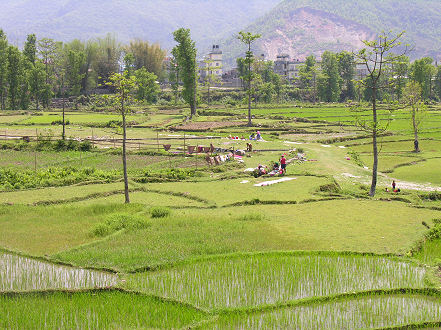 We had a full day starting with a row boat across the lake to the walking
trail up to the peace pagoda on top of a hill. Back down through a sal forest
where local women were out with their baskets collecting firewood and leaves,
for their goats. We managed to extend our one month visa to Nepal at the
immigration office, $US 30.00, just half an hour and were back at our accommodation
before an afternoon thunderstorm dumped a white coating of hail in the
garden, stripping plants of their leaves. Afternoon thunderstorms are a
feature of the area at this time of year. Situated with nearby mountains
and the lake the clouds start forming mid afternoon and dump heavy rain,
or hail, early evening, emptying the streets of shoppers.
We had a full day starting with a row boat across the lake to the walking
trail up to the peace pagoda on top of a hill. Back down through a sal forest
where local women were out with their baskets collecting firewood and leaves,
for their goats. We managed to extend our one month visa to Nepal at the
immigration office, $US 30.00, just half an hour and were back at our accommodation
before an afternoon thunderstorm dumped a white coating of hail in the
garden, stripping plants of their leaves. Afternoon thunderstorms are a
feature of the area at this time of year. Situated with nearby mountains
and the lake the clouds start forming mid afternoon and dump heavy rain,
or hail, early evening, emptying the streets of shoppers.
23/4/07 Pokhara has a motorcycle ethos. They can be rented
by tourists and are the main form of local transport. Backpackers often
bring Enfields from India and hang out here for weeks, or months, sometimes
settling in the region with a local partner. It is the first time in a
while where people have heard of Harley-Davidson. Having never seen one,
other than in movies or photos, our motorcycle attracts more attention
than we seek. Out for a morning ride to Sarangkot where the mountain views
were clear after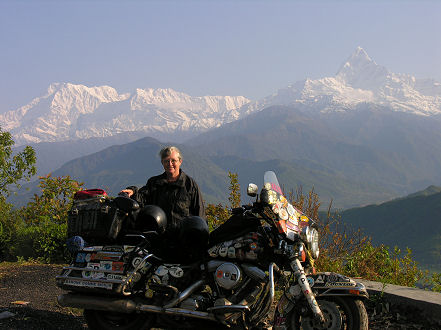 the last couple of days rain. Still looking for a reason the motorcycle
is running hot we removed the cylinder rocker covers to check oil flow
in that area and to make sure we had not incorrectly assembled any parts
after the rebuild. Almost hoping to find a problem, we were disappointed,
everything looked normal, at least as normal at two untrained backyard mechanics
could figure.
the last couple of days rain. Still looking for a reason the motorcycle
is running hot we removed the cylinder rocker covers to check oil flow
in that area and to make sure we had not incorrectly assembled any parts
after the rebuild. Almost hoping to find a problem, we were disappointed,
everything looked normal, at least as normal at two untrained backyard mechanics
could figure.
24/4/07 Someone once said you should rest on the seventh
day. I guess today was the seventh day.
25/4/07 We are really just waiting for the start of our
ten day rafting trip down the Karnali River starting on the 28th near
the Indian border. The handlebars on the motorcycle have been slipping
recently and despite tightening them a few times they keep loosening again.
We cleaned and roughened up the clamps for better binding. A considerable
job as the handlebars are under the fairing and beneath the radio, both
of which need to be removed. Pokhara has many Israeli backpackers. After
compulsory military service, starting when they are about 19 years old,
three years for men and two for women, they want a cheap holiday to unwind
and like other nationals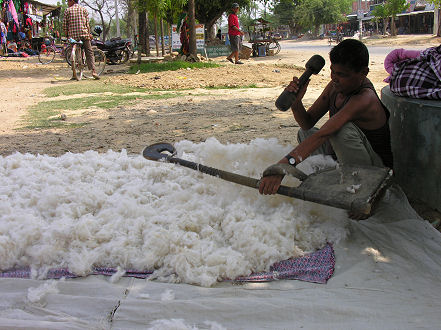 congregating in different parts of the world, Israeli's seem to like
Nepal, and Pokhara in particular. They generally mix only with other Israeli's,
groups eating in restaurants and moving about town, going rafting or
trekking. About half the young backpackers in Pokhara at the moment are
Israeli's.
congregating in different parts of the world, Israeli's seem to like
Nepal, and Pokhara in particular. They generally mix only with other Israeli's,
groups eating in restaurants and moving about town, going rafting or
trekking. About half the young backpackers in Pokhara at the moment are
Israeli's.
26/4/07 Since digital photography we are now keeping about
five photo's a day where previously the cost of print photos had kept it
to one or two a day. Too many travellers and ex-travellers we have met never
catalogue nor look back over their photos, ending up with boxes or hard
drives full of unused memories. Our lap top screen saver randomly goes
through our photo library, reminding us of previous events. Each photo is
captioned with the country, date and event making it a great memory jog,
particularly the older ones, eleven years ago, which if not viewed occasionally
fade from memory. The long term aim is to replace a wall painting, in our
house, when and if we return to sedentary life, with a flat screen that randomly
shows the photos. An ever varying wall hanging. Sometimes we get a bit behind
in the cataloguing, today we caught up, staying most of the day in the hotel
room. 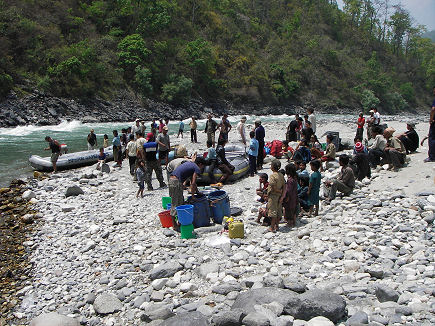
27/4/07 Finally had to leave the tourist enclave and quiet
streets of Pokhara and out along the great sceneried mountain road down
onto the Terai, the flatlands bordering India. Here with temperature increasing
rapidly to very high 30's we knew summer was pounding in. Morgan and Wackers,
the Harley dealer in Brisbane, by long distance email diagnosis, suggested
we look at the motorcycle's timing, amongst other suggestions, to help
reduce the overheating problem. Normally set with a timing light we have
had to guess it's correct setting. I had mistakenly thought that retarding
the timing would help the engine to cool where actually I now found out
that it makes the motor run hotter and advancing the timing, whilst increasing
the possibility of knocking (pinging) makes it run cooler. So before heading
out we advanced the timing, just a millimetre of adjustment. This certainly
helped a bit with cooling but increased pinging slightly. It now looks
like it might be, and still is a combination of factors, including poor
quality petrol and a newly rebuilt tighter engine. Whilst it is still heating
up after idling for some time and riding long uphill it has hopefully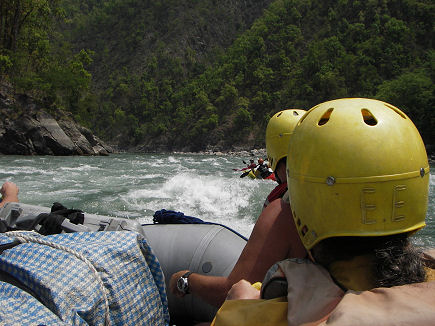 become a more manageable heat. The Terai is where most of Nepal's continuing
problems exist. There was a road block, a protest or strike, closing the
road to the west till 6pm. All cars, buses and trucks were lined up waiting.
Passengers were being ferried the 20km between military security by bicycle
rickshaws. Luckily motorcycles were also being allowed to pass and cautiously
we rode, being stopped by a line of rocks across the road midway. We were
politely waved around and continued, thankful we did not have to wait till
6pm and stayed in Kohalpur, and about 400km for the day.
become a more manageable heat. The Terai is where most of Nepal's continuing
problems exist. There was a road block, a protest or strike, closing the
road to the west till 6pm. All cars, buses and trucks were lined up waiting.
Passengers were being ferried the 20km between military security by bicycle
rickshaws. Luckily motorcycles were also being allowed to pass and cautiously
we rode, being stopped by a line of rocks across the road midway. We were
politely waved around and continued, thankful we did not have to wait till
6pm and stayed in Kohalpur, and about 400km for the day.
28/4/07 Wim and Petra, riding bicycles from Europe, and
who we had first met in Iran, are also doing the rafting trip. We had
arranged to meet at a local hotel, where we can store their bikes and
our motorcycle for the eight days of rafting. Not having met for three
months, they having given up bicycling in exchange for buying Indian Enfield
motorcycles whilst in India, but were now back on their bicycles. We had
plenty of catching up with lots of stories. The rafting bus arrived at
8pm with just three other rafters, an Australian, a Brit and a Canadian,
all males. We had been told there were to be a total of 15 on the trip,
perhaps just a sales pitch, the official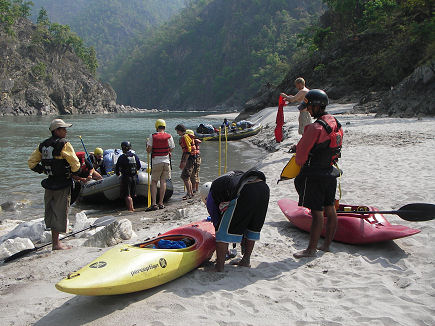 line was the rest of the group got sick? There were also five staff,
a good ratio for the seven rafters. After introductions everyone stayed
at the hotel for the night.
line was the rest of the group got sick? There were also five staff,
a good ratio for the seven rafters. After introductions everyone stayed
at the hotel for the night.
29/4/07 A 5am start towards the Karnali River with the
old Indian made Tata bus rattling along the road to Surkhet. Two years ago
this was as far as the road went. Rafters then had to hire porters and
do a two day trek to the river but as roads reach out to smaller and smaller
settlements in the hills our off road bus can now get right to the river.
After some discussion with local villagers, trying to insist we take their
bus for the remainder of the journey, we were allowed to proceed along
the winding track of a road, three hours to the river. Cut into the steep
mountains were rice terraces, their vertical walls often higher than the
horizontal growing area, we counted more than two hundred stepping up one
hillside. Locals were at a funeral, at the confluence of two rivers, when
we arrived and many migrated to watch us prepare the rafts, pumping them
up before eating a late lunch. With two rafts, one for most of the gear
and the other one for the passengers, plus three safety kayakers, we headed
down river for just half an hour, after brief rafting instruction, and set
up camp for a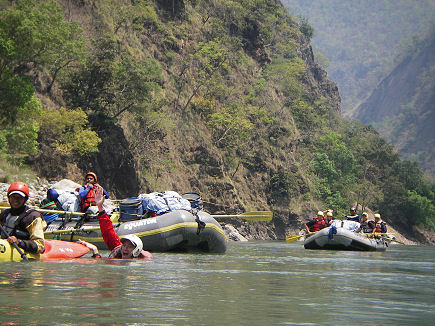 relaxing afternoon.
relaxing afternoon.
30/4/07 The cool riverside camp was pleasant after our
previous night's hot hotel. With just two candle power for evening light
and torches we had gone to bed early and were up at daylight, 5am. The river
temperature is still a cold 20 degrees coming mostly from snow melt. The
river height is now at its lowest, rising within the next few weeks as thunderstorms
precede the monsoon rains until it is too dangerous to raft in less than
a month's time. Rafting will not then be possible until October when water
levels again fall, making it a short season for rafting companies. Being Nepal's
largest river there is still plenty of water and after enjoying the cool
morning we were on the river at 9.30am and wet almost instantly as the first
set of rapids drenched the raft. With our personal camping gear strapped to
the centre, plus eight passengers, we are a sluggish raft, ploughing through
the rapids rather than bouncing over them. Today is billed as a get ready
day. Some exciting rapids but with bigger ones over the next two days. Our
team started to mesh together by afternoon and were responding quicker to
the guide's instructions. Positions in the raft were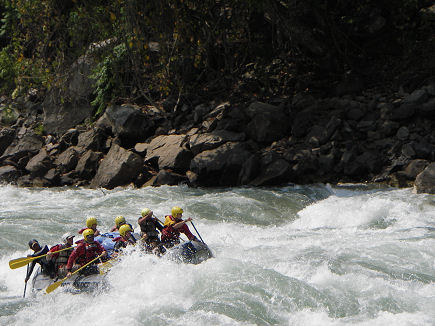 rotated, giving everyone a chance at the more exciting and demanding
front seats. The river moved continually so other than manoeuvring there
was no hard paddling. On longer drift sections we left the raft to swim,
floating and cooling off. There were a couple of troops of monkeys along
the bank and some hardy humans grazing a few goats or cattle. Our crew,
like most Nepalis, enjoy a bit of fun and splashing and throwing people
overboard became part of the trip. At the camp by 2pm, relaxed, reading
books, and playing cards into the evening.
rotated, giving everyone a chance at the more exciting and demanding
front seats. The river moved continually so other than manoeuvring there
was no hard paddling. On longer drift sections we left the raft to swim,
floating and cooling off. There were a couple of troops of monkeys along
the bank and some hardy humans grazing a few goats or cattle. Our crew,
like most Nepalis, enjoy a bit of fun and splashing and throwing people
overboard became part of the trip. At the camp by 2pm, relaxed, reading
books, and playing cards into the evening.
1/5/07 The riverside is dotted by occasional villages,
usually just a one family unit, trying to survive on a little rice growing
and a few animals. Fishing is also a good source of protein. They use dug
out canoes, a tree felled that is hollowed out, to cross the river, although
there are an increasing number of safer suspension bridges spanning it.
Our routine has now been established with hot water for coffee at 7am, cooked
breakfast at 8am, all gear to the rafts at 9am and a 9.30 departure. Sounds
regimented but the times are flexible with the rafters usually ready to
get underway earlier. Meals are laid out on a couple of boards and we sit
on the sandy beach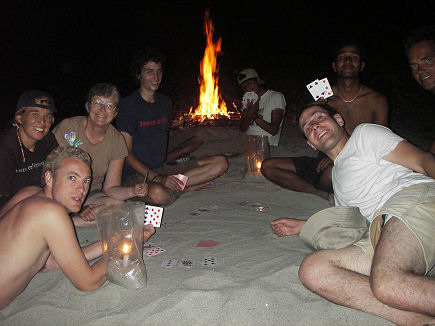 to eat. A toilet is dug each night in the sand, a small tarp for privacy,
filled in the next morning and the paper burnt. Nothing is left on river,
all rubbish is removed and hygiene is good. Water is drawn from the river
for drinking, cooking and washing vegetables, iodine purified or boiled.
The rapid size and difficulty increased today. We walked to look at three
sets to survey a route which changes each trip depending on the river level.
Some rapids are more difficult in low water as now exposed rocks need to
be manoeuvred around whilst others are more difficult in high water as large
standing or breaking waves can capture the raft. The major concern is flipping,
usually after getting caught in a hole. There was a little nervous tense
apprehension between a couple of the paddlers leading up to one rapid which
soon passed afterwards. Two of these rapids went as planned but the third,
where we had to negotiate between two rocks had us missing the line, running
into one rock, spinning and proceeding backwards with us almost falling into
an enormous hole. Afterwards we again cooled down from the high 30's temperature
out of the water to the cold 20 degree river by floating through small rapids.
to eat. A toilet is dug each night in the sand, a small tarp for privacy,
filled in the next morning and the paper burnt. Nothing is left on river,
all rubbish is removed and hygiene is good. Water is drawn from the river
for drinking, cooking and washing vegetables, iodine purified or boiled.
The rapid size and difficulty increased today. We walked to look at three
sets to survey a route which changes each trip depending on the river level.
Some rapids are more difficult in low water as now exposed rocks need to
be manoeuvred around whilst others are more difficult in high water as large
standing or breaking waves can capture the raft. The major concern is flipping,
usually after getting caught in a hole. There was a little nervous tense
apprehension between a couple of the paddlers leading up to one rapid which
soon passed afterwards. Two of these rapids went as planned but the third,
where we had to negotiate between two rocks had us missing the line, running
into one rock, spinning and proceeding backwards with us almost falling into
an enormous hole. Afterwards we again cooled down from the high 30's temperature
out of the water to the cold 20 degree river by floating through small rapids.
2/5/07 With three safety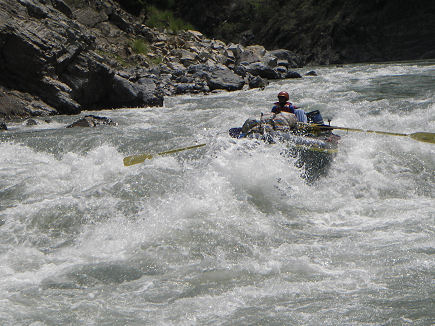 kayakers we can enjoy the luxury of having one take photos at some
interesting rapids. We brought Kay's smaller waterproof camera, good to
just 1.5 metres depth, but enough to keep out the sand and rafting spray.
The rafters, a little more relaxed today, tensions a little eased, quieter
from tiredness rather than nerves. It had rained overnight upriver, just
a few drops on us, but the water was still blue green and at the same level.
Probably the most exciting day, a couple of class 4 and many class 3 rapids
with an almost continuous drop and only short rests between. It is a full
moon, today is Buddha's birthday so for a bit of celebration, getting through
all the more difficult rapids without flipping the raft or popcorning anyone,
(falling out of the raft), although Charlie, the Brit, went incredibly close,
we had bought 5 litres of the local rice alcohol from a small riverside settlement.
Distilled to about 40% and almost tasteless, the locals like it straight,
but westerners prefer it with a couple of herbs, lemon, some floating pieces
of apple, like a punch, this is how we drank it in the evening. We also stopped
to buy some local chickens. After negotiating the price they had to be caught,
chasing them around the settlement until six were inside a bamboo basket.
Tied onto our
kayakers we can enjoy the luxury of having one take photos at some
interesting rapids. We brought Kay's smaller waterproof camera, good to
just 1.5 metres depth, but enough to keep out the sand and rafting spray.
The rafters, a little more relaxed today, tensions a little eased, quieter
from tiredness rather than nerves. It had rained overnight upriver, just
a few drops on us, but the water was still blue green and at the same level.
Probably the most exciting day, a couple of class 4 and many class 3 rapids
with an almost continuous drop and only short rests between. It is a full
moon, today is Buddha's birthday so for a bit of celebration, getting through
all the more difficult rapids without flipping the raft or popcorning anyone,
(falling out of the raft), although Charlie, the Brit, went incredibly close,
we had bought 5 litres of the local rice alcohol from a small riverside settlement.
Distilled to about 40% and almost tasteless, the locals like it straight,
but westerners prefer it with a couple of herbs, lemon, some floating pieces
of apple, like a punch, this is how we drank it in the evening. We also stopped
to buy some local chickens. After negotiating the price they had to be caught,
chasing them around the settlement until six were inside a bamboo basket.
Tied onto our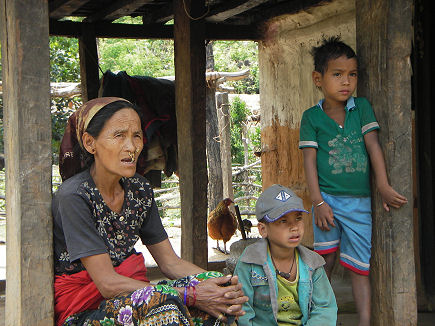 provisions raft they enjoyed the next few sets of rapids before becoming
curried for the celebrations. Scott, the other Australian, built a fishing
pole, and each morning tries his luck, one edible fish was caught the first
day, a couple of bites and as is often the case the big one was almost landed
but survived. Another beautiful sandy beach camp.
provisions raft they enjoyed the next few sets of rapids before becoming
curried for the celebrations. Scott, the other Australian, built a fishing
pole, and each morning tries his luck, one edible fish was caught the first
day, a couple of bites and as is often the case the big one was almost landed
but survived. Another beautiful sandy beach camp.
3/5/07 The water from the thunderstorm two nights ago had
arrived this morning, raising the river level by 15cm and turned it brown.
Kynan the Canadian, had also recently done a kayak course and today, with
the difficult rapids behind us, we left the raft to try kayaking. The others
had an opportunity to try their hand at rowing the gear raft, controlling
our raft, fishing as we drifted or just relaxing looking at the scenery,
while the staff almost slept they were so relaxed. The Seti River joined
us before lunch swelling waters more and the narrow gorge between mountains,
that we have had the last few days, started to widen but with the larger
volume it was still deep and fast flowing. The rapids were exciting enough
for my level of kayaking and the deep swirling waters flipping the kayak over
at the bottom of one set. After an attempted roll, unsuccessful in the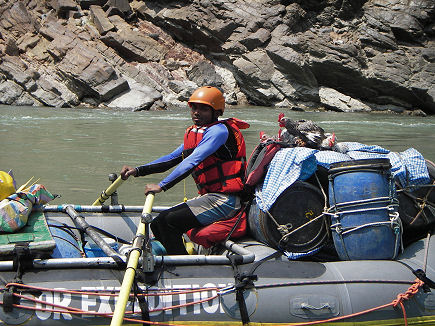 strong swirling water I exited the kayak and was towed ashore. We tried
to buy fish for dinner from one village, as they only had a massive 26kg
cat fish, too big for our needs, it was vegetarian tonight. Charlie and Scott
had a kayak lesson at the campsite in late afternoon but it is difficult
to try learning in this river. Smoke filled the afternoon air with locals
burning leaves and undergrowth before the monsoon rains and small fires dotted
the hills lighting up the night sky.
strong swirling water I exited the kayak and was towed ashore. We tried
to buy fish for dinner from one village, as they only had a massive 26kg
cat fish, too big for our needs, it was vegetarian tonight. Charlie and Scott
had a kayak lesson at the campsite in late afternoon but it is difficult
to try learning in this river. Smoke filled the afternoon air with locals
burning leaves and undergrowth before the monsoon rains and small fires dotted
the hills lighting up the night sky.
4/5/07 Quite exhausted from yesterday's all day kayaking
I decided to join Kay on the slow but steady drift of the raft watching
the small village life where children run to the river bank waving as we
pass by. We have not heard any mechanical noise since the first day on the
river showing how simple the lives of these people are. Thunderstorms started
to build soon after lunch and by the time we reached campsite it was raining
and cooling the air nicely for an evening campfire. The river had widened
to a gravely bottom, it's banks of conglomerate rock carved by monsoon floods.
The crew, constantly happy, young and enthusiastic, spent much of the drift
time in "horseplay".
5/5/07 We are all feeling the end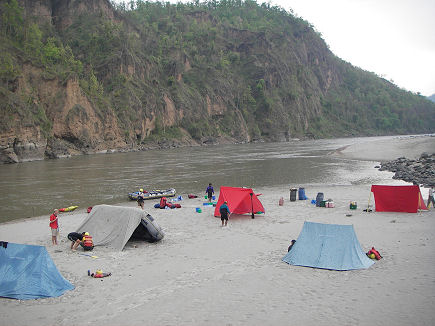 of a trip no-one wants to end. I was back in the kayak for a long morning
as we decided to set up camp by lunch time, just an hour short of our take
out spot tomorrow. The river is still growing in size. The Bheri River joined
the Karnali this morning, and whilst there are only a few low grade rapids
the sheer volume of water, viewed from my kayak is daunting. It was Ramesh's
birthday, one of the crew, and the cook managed to bake a cake and again
we had rakshi, the local alcohol for an evening celebration.
of a trip no-one wants to end. I was back in the kayak for a long morning
as we decided to set up camp by lunch time, just an hour short of our take
out spot tomorrow. The river is still growing in size. The Bheri River joined
the Karnali this morning, and whilst there are only a few low grade rapids
the sheer volume of water, viewed from my kayak is daunting. It was Ramesh's
birthday, one of the crew, and the cook managed to bake a cake and again
we had rakshi, the local alcohol for an evening celebration.
6/5/07 A large Japanese built suspension bridge crosses
the river where we leave it and gave opportunity for last photos. The hard
work of carrying all the gear, including rafts up the bank to the road began,
but the bus was nowhere to be seen. Another demonstration protest road
block was delaying it just 23km away. Landless people, supported by the
Maoists, had been blocking the road for the last three days preventing all
vehicle movement through the west of Nepal, a couple of government buildings
had been burnt and the situation was reportedly tense. We waited over an
early lunch pondering what to do when a 4x4 flying the red and white Maoist
flag pulled up advising the road had been opened. Our bus arrived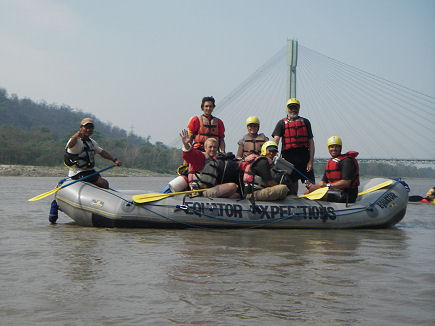 soon after and we quickly loaded and left fearing the road may again
be closed. Back at the hotel in Kohalpur we said our goodbye's and were
reunited with the motorcycle.
soon after and we quickly loaded and left fearing the road may again
be closed. Back at the hotel in Kohalpur we said our goodbye's and were
reunited with the motorcycle.
7/5/07 We had arranged to meet up with four of the rafters
at Bardia National Park to exchange photos. It was lunch time when we arrived,
the road was still open but large river rocks blocked one lane and it could
be easily closed again. Bardia has not been receiving many tourists as it
is situated in a strong Maoist region. Since the Maoists have been recently
accepted as part of the official government, tourist numbers have been slowly
increasing. The Karnali breaks up into a delta of rivers running into the
park and we were taken down to an area where elephants are kept and bred
for ranger patrolling of the wildlife and tourist rides. A small orphaned
baby elephant is currently the highlight. With his human handling he revels
in being bathed and patted and tests his strength by pushing people about.
8/5/07 It is the first opportunity we have had to relax
since starting the rafting and catching up with jobs. We are staying in
an elephant grass and mud walled hut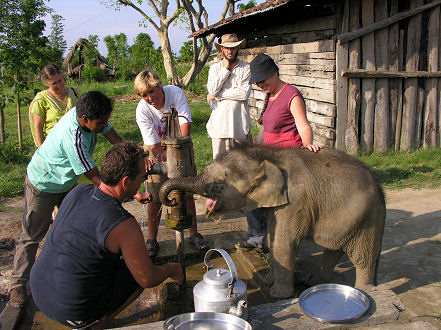 with grass roof. Much of the accommodation here is of the local built
variety, cooler in the night than concrete structures. It is Wim's birthday,
a pan"cake" with candles, some more locally brewed rice wine and rice moonshine,
a good group of friends.
with grass roof. Much of the accommodation here is of the local built
variety, cooler in the night than concrete structures. It is Wim's birthday,
a pan"cake" with candles, some more locally brewed rice wine and rice moonshine,
a good group of friends.
9/5/07 The Karnali, after our rafting pull-out bridge two
days ago, breaks up into a braided river as it levels out, depositing silt
and rocks onto the plains. It breaks up into many branches as it flows through
Bardia National Park. We were again back on the river, this time in a small
raft, seven of us plus two park guides, looking for wildlife, drifting slowly,
weaving between islands. At one stop, the guide spotted a lone bull elephant,
close enough to create caution. He sensed us and took on a defensive stance
and we backed away. Few other animals were seen as a thunderstorm swept through
dumping us with cold rain till we took refuge in a watch tower for lunch,
drenched. At another watch tower three rhino were seen at a long distance
along with deer. Despite the rain it was a great day, but the high river
bank sometimes blocked out longer distance views where animals might have
been spotted.
10/5/07 Two friends tried to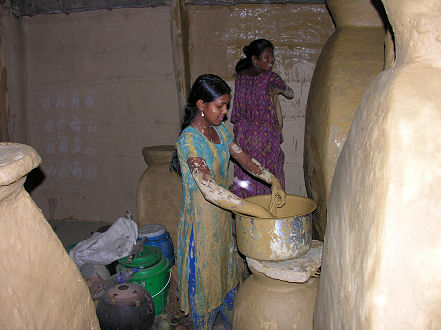 leave the national park today but another road block, or the same one,
doesn't seem to matter, prevented them from doing so until late in the afternoon.
Today's protest seems to be against the government's handling of the AIDS
problem. No vehicles are moving towards the East. Armed with a detailed email
from Morgan and Wacker's head mechanic of possible causes for the motorcycle's
overheating we again started investigating. Exhaust leaks, timing, fuel
too lean, possible incorrect gasket, blocked lifter screen, oil flow blockage,
all checked but nothing concrete could be identified as causing the problem.
We are now at a total loss as to the cause.
leave the national park today but another road block, or the same one,
doesn't seem to matter, prevented them from doing so until late in the afternoon.
Today's protest seems to be against the government's handling of the AIDS
problem. No vehicles are moving towards the East. Armed with a detailed email
from Morgan and Wacker's head mechanic of possible causes for the motorcycle's
overheating we again started investigating. Exhaust leaks, timing, fuel
too lean, possible incorrect gasket, blocked lifter screen, oil flow blockage,
all checked but nothing concrete could be identified as causing the problem.
We are now at a total loss as to the cause.
11/5/07 Another email and a few more things to check on
the motorcycle and we have now eliminated everything we can think to do without
pulling the engine apart. It is time to just accept the problem will either
go away or eventually destroy the engine. It limits us to having to stop
if there is too much traffic to let the engine cool, or if going up hill
for a prolonged period. We have been staying at Bardia Adventure Resort where
the manager has been incredibly generous, taking us to the elephant breeding
facility, even giving us a local meal for no cost. Competition here is fierce
for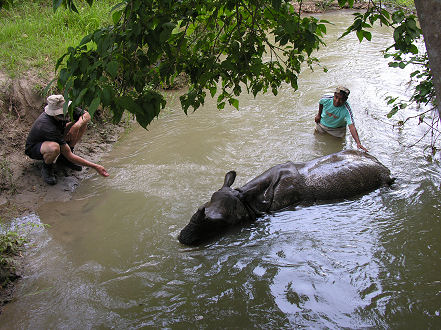 tourists. While some places try to get as much as they can by overpricing
everything, others, like where we are staying, offer a few, at little cost
to them, extras, so people will feel more relaxed and decide to stay longer
and recommend the place. It certainly worked with us, now staying five nights.
tourists. While some places try to get as much as they can by overpricing
everything, others, like where we are staying, offer a few, at little cost
to them, extras, so people will feel more relaxed and decide to stay longer
and recommend the place. It certainly worked with us, now staying five nights.
12/5/07 Decided to stay another night, needed to do washing,
well that was the excuse. The manager took us, again for free, to a couple
of local village houses to see how the local people live. The elephant grass
and mud walls with thatch roof contain the three or four generation family
of perhaps a dozen people. Grain is kept inside, in mud containers built
into the walls. The kitchen is a basic wood fire and everywhere mud dirt floor.
Electricity has only been in the region for the last two years and only the
more wealthy have it connected. At one house the women were freshening up
the walls with a new coat of mud, they seemed to be getting almost as
much on themselves as the walls and floors. We were also taken to see an
orphaned rhino, now seven years old, he is almost sexually mature and needs
to be locked up at night to prevent damage to the village crops however during
the day he wanders about.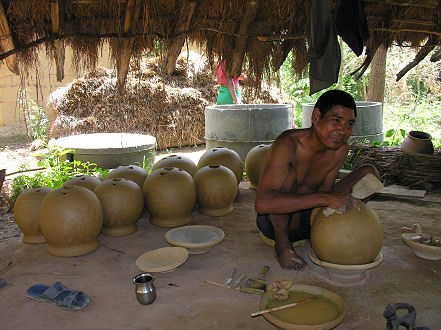 The guide and I got a little bit too close at one stage while he was
having a cooling dip in a stream and incredibly agile he leapt up and faced
us to show he was not happy. Not aggressive but we certainly had no doubt
he wanted to be left alone.
The guide and I got a little bit too close at one stage while he was
having a cooling dip in a stream and incredibly agile he leapt up and faced
us to show he was not happy. Not aggressive but we certainly had no doubt
he wanted to be left alone.
13/5/07 Finally it becomes time to move. Not looking forward
to heading back into hectic India we have procrastinated here as long as
we can. Wim and Petra also left, heading in the other direction. A couple
of hours to the western border and an easy crossing out of Nepal.
Move with us to India
Home
 27/3/07 Another warm welcoming from
the Nepalese Authorities but unfortunately they have a strange visa
policy. On a second entry to the country in the same year, they will
only give a 30 day visa, not the normal 60 days, despite us only
having stayed 6 days on our previous visit. This cost $US 30.00, however
if we had stayed a minimum of 15 days previously we would have received
a free 30 day visa? A little awkward as we want to stay longer than
30 days, but if we again leave the country, for at least one night, we
will receive a free 30 day visa on our re-entry, this year. I don't
know who dreams up these complicated visa rules. Customs was easier,
accepting the carnet, even though they are not a signatory to the agreement.
We moved onto Lumbini for the night.
27/3/07 Another warm welcoming from
the Nepalese Authorities but unfortunately they have a strange visa
policy. On a second entry to the country in the same year, they will
only give a 30 day visa, not the normal 60 days, despite us only
having stayed 6 days on our previous visit. This cost $US 30.00, however
if we had stayed a minimum of 15 days previously we would have received
a free 30 day visa? A little awkward as we want to stay longer than
30 days, but if we again leave the country, for at least one night, we
will receive a free 30 day visa on our re-entry, this year. I don't
know who dreams up these complicated visa rules. Customs was easier,
accepting the carnet, even though they are not a signatory to the agreement.
We moved onto Lumbini for the night.  28/3/07 Lumbini is effectively the end of our Buddhist
trail. It was here that Buddha was born about 2500 years ago. A stone,
recently uncovered, is said to mark the exact spot, in the ruins
of a 3rd century BC temple, beside a pond where his mother washed
before she stumbled a few steps and hanging onto the branch of a sal
tree gave birth. A large site of about 3 sq/km has been set aside for
development of international monasteries, stupas, pagodas and temples
to honour the birth. A recent interest has about ten new buildings
under construction from Buddhist societies around the world. Some are
enormous structures like the Japanese World Peace Pagoda or the lavish
German Lotus Stupa, or the Chinese Monastery. We hired a couple of bicycles
to tour the vehicle free grounds, and were again charged a different
fee for foreigners, compared with locals, to enter the site of Buddha's
birth. Amazingly western photos are also somehow different from local's
photos as western cameras are charged five times the local's price.
We voiced our displeasure with this ridiculous two priced situation,
to such an important international site,
28/3/07 Lumbini is effectively the end of our Buddhist
trail. It was here that Buddha was born about 2500 years ago. A stone,
recently uncovered, is said to mark the exact spot, in the ruins
of a 3rd century BC temple, beside a pond where his mother washed
before she stumbled a few steps and hanging onto the branch of a sal
tree gave birth. A large site of about 3 sq/km has been set aside for
development of international monasteries, stupas, pagodas and temples
to honour the birth. A recent interest has about ten new buildings
under construction from Buddhist societies around the world. Some are
enormous structures like the Japanese World Peace Pagoda or the lavish
German Lotus Stupa, or the Chinese Monastery. We hired a couple of bicycles
to tour the vehicle free grounds, and were again charged a different
fee for foreigners, compared with locals, to enter the site of Buddha's
birth. Amazingly western photos are also somehow different from local's
photos as western cameras are charged five times the local's price.
We voiced our displeasure with this ridiculous two priced situation,
to such an important international site, where almost all development
money has come from foreign donors, only to be insulted by being
charged a discriminatory entrance fee, to little effect, to an uncaring
official who had obviously had many similar such complaints. An
interesting aside was watching about a hundred vultures compete with
half a dozen dogs for the carcass of a recently dead steer. The remains
were stripped bare within an hour of our watching, leaving only the
skeleton. It is a jailable offence to kill a cow in the Hindu Nepalese
society. Cows are kept for milking and breeding, some steers are used
in the fields or for carting goods but there is often a surplus. Water buffalo's are different, making it to restaurant menu's,
and are often the preferred work animal on farms. The dead steer had been skinned and it's ears removed making
any identification impossible.
where almost all development
money has come from foreign donors, only to be insulted by being
charged a discriminatory entrance fee, to little effect, to an uncaring
official who had obviously had many similar such complaints. An
interesting aside was watching about a hundred vultures compete with
half a dozen dogs for the carcass of a recently dead steer. The remains
were stripped bare within an hour of our watching, leaving only the
skeleton. It is a jailable offence to kill a cow in the Hindu Nepalese
society. Cows are kept for milking and breeding, some steers are used
in the fields or for carting goods but there is often a surplus. Water buffalo's are different, making it to restaurant menu's,
and are often the preferred work animal on farms. The dead steer had been skinned and it's ears removed making
any identification impossible.  how he shows himself. Added to these there can be an
associated animal, monkey, bull, and consorts. There are temples
in every small town and almost every temple shows a different form
or manifestation that is worshiped. It is a complicated religion to understand
and follow. Hinduism is taken very seriously in Nepal and moreso at
Devghat. Here two rivers meet, later flowing into the Ganges River in
India, and many feel this is the most sacred place for Hindu's to die
in Nepal. Old people congregate, bathe daily at the rivers confluence, waiting
out the last years of their lives, and will be cremated at this confluence.
A quiet, vehicle free town, accessed only by a long pedestrian suspension
bridge across one of the rivers, we walked to the confluence this morning
and quietly watched as the elderly ritually bathed and threw offerings
of petals into the waters. Rode on to Chitwan National Park later in the
day.
how he shows himself. Added to these there can be an
associated animal, monkey, bull, and consorts. There are temples
in every small town and almost every temple shows a different form
or manifestation that is worshiped. It is a complicated religion to understand
and follow. Hinduism is taken very seriously in Nepal and moreso at
Devghat. Here two rivers meet, later flowing into the Ganges River in
India, and many feel this is the most sacred place for Hindu's to die
in Nepal. Old people congregate, bathe daily at the rivers confluence, waiting
out the last years of their lives, and will be cremated at this confluence.
A quiet, vehicle free town, accessed only by a long pedestrian suspension
bridge across one of the rivers, we walked to the confluence this morning
and quietly watched as the elderly ritually bathed and threw offerings
of petals into the waters. Rode on to Chitwan National Park later in the
day. from reduced animal numbers in the park due to poaching,
whilst the governments attentions have been elsewhere. Nepali tourists
have increased recently as travel within their own country has become
safer. There are still enough visitors to demand elephant rides, and
the elephants need bathing, which happens in the river each day outside
our hotel. About eight elephants, with mahouts, arrived after the morning's
rides. Anyone, for the price of a donation, can help wash the elephants,
getting to ride them into the water and getting a shower from it's trunk.
A relaxed fun time for the elephants they seem to enjoy the excitement,
screams and laughing as the tourists get drenched.
from reduced animal numbers in the park due to poaching,
whilst the governments attentions have been elsewhere. Nepali tourists
have increased recently as travel within their own country has become
safer. There are still enough visitors to demand elephant rides, and
the elephants need bathing, which happens in the river each day outside
our hotel. About eight elephants, with mahouts, arrived after the morning's
rides. Anyone, for the price of a donation, can help wash the elephants,
getting to ride them into the water and getting a shower from it's trunk.
A relaxed fun time for the elephants they seem to enjoy the excitement,
screams and laughing as the tourists get drenched. than anticipated. A young five year old, the elephant
was enjoying lying in the current and was not too excited about giving
a tourist a ride. Despite much encouragement from it's mahout, the elephant,
each time Kay tried to climb aboard, decided to bury it's head under
the water and roll over to one side, dislodging Kay. It rose onto it's
front legs a few times, with Kay aboard, but left it's rear end on the
river bed, to the great humour of Kay and the mahout. The young elephant
seemed to be more playful than wilful in it's antics.
than anticipated. A young five year old, the elephant
was enjoying lying in the current and was not too excited about giving
a tourist a ride. Despite much encouragement from it's mahout, the elephant,
each time Kay tried to climb aboard, decided to bury it's head under
the water and roll over to one side, dislodging Kay. It rose onto it's
front legs a few times, with Kay aboard, but left it's rear end on the
river bed, to the great humour of Kay and the mahout. The young elephant
seemed to be more playful than wilful in it's antics.  still wearing bandages from a rhino attack three weeks
ago, was extremely cautious. To get to the tower we needed to be
shepherded, elephants between us and the rhino, so as not to disturb
them. The tower has views over a cleared part of the forest where deer
and pigs come down to graze. On dusk we went for another walk, this time
coming across a rhino wallowing in a drying up pool. A little disturbed
by our sudden appearance he rose as if to give chase which was enough
to have us moving quickly away. Rhino are short sighted and have poor
hearing which means they can be approached quite closely but have a reputation
for aggression, charging at anything. The night passed in the watchtower
with only jungle sounds and a few distant town dogs.
still wearing bandages from a rhino attack three weeks
ago, was extremely cautious. To get to the tower we needed to be
shepherded, elephants between us and the rhino, so as not to disturb
them. The tower has views over a cleared part of the forest where deer
and pigs come down to graze. On dusk we went for another walk, this time
coming across a rhino wallowing in a drying up pool. A little disturbed
by our sudden appearance he rose as if to give chase which was enough
to have us moving quickly away. Rhino are short sighted and have poor
hearing which means they can be approached quite closely but have a reputation
for aggression, charging at anything. The night passed in the watchtower
with only jungle sounds and a few distant town dogs. we surmised the oil pump as the likely problem.
It seems there is leakage somewhere and when the oil is hot and thin
insufficient pressure can be obtained and the engine runs hot. We continued
on to Daman at the top of the mountain range, where an old run down two
storied stone building was our accommodation. The first floor wooden balcony
barely supported our weight and the rammed earthen floor was ripply from
sagging beams. It was quaint and comfortable and we were left alone, the
building to ourselves for the day, the owner returning in the evening.
we surmised the oil pump as the likely problem.
It seems there is leakage somewhere and when the oil is hot and thin
insufficient pressure can be obtained and the engine runs hot. We continued
on to Daman at the top of the mountain range, where an old run down two
storied stone building was our accommodation. The first floor wooden balcony
barely supported our weight and the rammed earthen floor was ripply from
sagging beams. It was quaint and comfortable and we were left alone, the
building to ourselves for the day, the owner returning in the evening.
 oil pump off the motorcycle. A question often asked is
can we fix everything on the motorcycle. The answer, only things
that have previously broken. As the oil pump has not previously needed
repairs we were opening it for the first time. An oil seal looks to
have hardened and along with scoring to the pump wall, likely done when
we had a cam follower collapse in Russia two years ago, it seems the
oil pump could be the likely oil pressure culprit.
oil pump off the motorcycle. A question often asked is
can we fix everything on the motorcycle. The answer, only things
that have previously broken. As the oil pump has not previously needed
repairs we were opening it for the first time. An oil seal looks to
have hardened and along with scoring to the pump wall, likely done when
we had a cam follower collapse in Russia two years ago, it seems the
oil pump could be the likely oil pressure culprit. Embassy this morning, early. We had been warned of long
lines and slow processing so at 6am we were at the gates only to be
told the embassy was closed for the Easter holiday. Easter holiday
in Nepal, a Hindu country? Easter holiday at the Indian Embassy? We emailed
our son and the Harley dealer in Australia, Morgan and Wackers, to see
if they had an oil pump in stock, and hopefully will have it sent to Kathmandu.
Kathmandu is modern enough, or receives enough tourists, that it has a
couple of wifi, wireless internet connection points, a first for us, and
we used the lap top to surf the net while sitting in a comfortable restaurant
most of the afternoon and evening, enjoying drinks and a meal and conversation.
Embassy this morning, early. We had been warned of long
lines and slow processing so at 6am we were at the gates only to be
told the embassy was closed for the Easter holiday. Easter holiday
in Nepal, a Hindu country? Easter holiday at the Indian Embassy? We emailed
our son and the Harley dealer in Australia, Morgan and Wackers, to see
if they had an oil pump in stock, and hopefully will have it sent to Kathmandu.
Kathmandu is modern enough, or receives enough tourists, that it has a
couple of wifi, wireless internet connection points, a first for us, and
we used the lap top to surf the net while sitting in a comfortable restaurant
most of the afternoon and evening, enjoying drinks and a meal and conversation.
 for fertility, rain making, making money, and even a large piece
of wood, where if a coin is nailed into it, it is supposed to cure toothache.
And just in case that doesn't cure the toothache, there are plenty
of western style dentists in the area. We wandered, sat and watched
the faithful go through their morning rituals and incantations before
their preferred deity, wondering if the west is vastly different with
it's array of saints and high church rites. The food offerings are removed
by the thousands of pigeons and a few fat cows that benefit from the generosity.
for fertility, rain making, making money, and even a large piece
of wood, where if a coin is nailed into it, it is supposed to cure toothache.
And just in case that doesn't cure the toothache, there are plenty
of western style dentists in the area. We wandered, sat and watched
the faithful go through their morning rituals and incantations before
their preferred deity, wondering if the west is vastly different with
it's array of saints and high church rites. The food offerings are removed
by the thousands of pigeons and a few fat cows that benefit from the generosity.
 tourists don't want to be pestered by them. They seem to understand
tourists like to shop unpressured, and will ultimately buy more. Kathmandu
is one of the world's hardest sell places, from cycle rickshaws to tatty
dressed women with babies at hip begging, they interrupt to get attention,
cut people off by walking or standing in front of them, tug onto their
shirt sleeve, refuse to take no for an answer, even if it is repeated
many times. It is the burden of the haves and the weapon of the have
nots, guilt, a weapon that works well with polite new western tourists
who have often seen poverty on television and are now fronted with it
for the first time. In all our travels we have not found a universal way
to easily and politely deter beggars and touts. We have tried to ignore
them, say no once, repeat the no, occasionally raise our voice, shrug our
shoulders, look them in the eye, avoid eye contact, but they are experts
at their job and often have the added incentive that comes with hunger,
their persistence levels can be greater than most people's tolerance levels.
What really amazes me is do they feel by pestering more, people are more
likely to give a donation, buy from them, or use their services, when
by the time they have become annoying they are
tourists don't want to be pestered by them. They seem to understand
tourists like to shop unpressured, and will ultimately buy more. Kathmandu
is one of the world's hardest sell places, from cycle rickshaws to tatty
dressed women with babies at hip begging, they interrupt to get attention,
cut people off by walking or standing in front of them, tug onto their
shirt sleeve, refuse to take no for an answer, even if it is repeated
many times. It is the burden of the haves and the weapon of the have
nots, guilt, a weapon that works well with polite new western tourists
who have often seen poverty on television and are now fronted with it
for the first time. In all our travels we have not found a universal way
to easily and politely deter beggars and touts. We have tried to ignore
them, say no once, repeat the no, occasionally raise our voice, shrug our
shoulders, look them in the eye, avoid eye contact, but they are experts
at their job and often have the added incentive that comes with hunger,
their persistence levels can be greater than most people's tolerance levels.
What really amazes me is do they feel by pestering more, people are more
likely to give a donation, buy from them, or use their services, when
by the time they have become annoying they are likely the last person most people would think of dealing with.
This also is their power. A beggar can annoy someone far beyond what
would be tolerated from anyone else. Few would side with a foreigner
who raises his voice, or threatens a local beggar, no matter how obnoxious
or rude they became.
likely the last person most people would think of dealing with.
This also is their power. A beggar can annoy someone far beyond what
would be tolerated from anyone else. Few would side with a foreigner
who raises his voice, or threatens a local beggar, no matter how obnoxious
or rude they became.  seen each day, and a surplus of applicants.
seen each day, and a surplus of applicants.  at Pashupatinath where like in India people are cremated on an
open wood fire, their ashes then washed into the sacred river.
at Pashupatinath where like in India people are cremated on an
open wood fire, their ashes then washed into the sacred river.  reasoning as to how things happen, or don't happen in India. We
can return again, line up again, mid next week, to see if the Indian
Embassy in Australia has replied to the telex. I have had sore gums for
the last couple of months and decide to see a dentist. The one recommended
by a western hotel was basic. The dentist advising me that there are no
regulations relating to dentists in Nepal and that most are staffed by,
at best, a technician, not a qualified dentist. Looking further into a
country of few regulations we read the label of a jar of honey which purports
to cure anything from bronchitis to tuberculosis. It can increase memory
power and is useful for "players"?
reasoning as to how things happen, or don't happen in India. We
can return again, line up again, mid next week, to see if the Indian
Embassy in Australia has replied to the telex. I have had sore gums for
the last couple of months and decide to see a dentist. The one recommended
by a western hotel was basic. The dentist advising me that there are no
regulations relating to dentists in Nepal and that most are staffed by,
at best, a technician, not a qualified dentist. Looking further into a
country of few regulations we read the label of a jar of honey which purports
to cure anything from bronchitis to tuberculosis. It can increase memory
power and is useful for "players"? Western boom boom dance music penetrated every hotel room and
we almost slept, with earplugs.
Western boom boom dance music penetrated every hotel room and
we almost slept, with earplugs. had us continuing into the mountains.
had us continuing into the mountains.  the night at the camp and hit a more difficult section of the
river tomorrow.
the night at the camp and hit a more difficult section of the
river tomorrow. with more successful eskimo rolls and feeling comfortable we again
hit the lower river, travelling six km's. There are no rafters or kayakers
here today so the riverside is ours alone. A few more practice eskimo
rolls in the swirling river waters and a few hard paddling exercises. Flipped
over accidentally in one rapid and after unsuccessfully trying to roll
back upright on my own I needed a T-rescue. Whilst drifting upside down
the instructor places his kayak in a position for me to use it as leverage
to roll upright. Much better than a self rescue, which involves leaving
the kayak and bobbing in the rapids. Being the only student progress moves
at my energy levels so we had this afternoon off, enjoying the riverside
camp.
with more successful eskimo rolls and feeling comfortable we again
hit the lower river, travelling six km's. There are no rafters or kayakers
here today so the riverside is ours alone. A few more practice eskimo
rolls in the swirling river waters and a few hard paddling exercises. Flipped
over accidentally in one rapid and after unsuccessfully trying to roll
back upright on my own I needed a T-rescue. Whilst drifting upside down
the instructor places his kayak in a position for me to use it as leverage
to roll upright. Much better than a self rescue, which involves leaving
the kayak and bobbing in the rapids. Being the only student progress moves
at my energy levels so we had this afternoon off, enjoying the riverside
camp. on the second attempt, and we finished without further adrenaline.
Less than two hours on the river this morning and again I was exhausted
but pleased with the results. A celebratory couple of cold beers in the
evening rounded off our stay here.
on the second attempt, and we finished without further adrenaline.
Less than two hours on the river this morning and again I was exhausted
but pleased with the results. A celebratory couple of cold beers in the
evening rounded off our stay here.  partially blocking one of the oil lines but a new pump at almost half
a million km's is probably necessary. We won't know if this solves the
low oil pressure problem until the motorcycle is run for a couple of hours,
tomorrow. We joined Tracy and Steve again for dinner. They are here for
a trek to Everest Base Camp, starting tomorrow and spent the day looking
around Kathmandu's sights.
partially blocking one of the oil lines but a new pump at almost half
a million km's is probably necessary. We won't know if this solves the
low oil pressure problem until the motorcycle is run for a couple of hours,
tomorrow. We joined Tracy and Steve again for dinner. They are here for
a trek to Everest Base Camp, starting tomorrow and spent the day looking
around Kathmandu's sights.  We had a full day starting with a row boat across the lake to the walking
trail up to the peace pagoda on top of a hill. Back down through a sal forest
where local women were out with their baskets collecting firewood and leaves,
for their goats. We managed to extend our one month visa to Nepal at the
immigration office, $US 30.00, just half an hour and were back at our accommodation
before an afternoon thunderstorm dumped a white coating of hail in the
garden, stripping plants of their leaves. Afternoon thunderstorms are a
feature of the area at this time of year. Situated with nearby mountains
and the lake the clouds start forming mid afternoon and dump heavy rain,
or hail, early evening, emptying the streets of shoppers.
We had a full day starting with a row boat across the lake to the walking
trail up to the peace pagoda on top of a hill. Back down through a sal forest
where local women were out with their baskets collecting firewood and leaves,
for their goats. We managed to extend our one month visa to Nepal at the
immigration office, $US 30.00, just half an hour and were back at our accommodation
before an afternoon thunderstorm dumped a white coating of hail in the
garden, stripping plants of their leaves. Afternoon thunderstorms are a
feature of the area at this time of year. Situated with nearby mountains
and the lake the clouds start forming mid afternoon and dump heavy rain,
or hail, early evening, emptying the streets of shoppers. the last couple of days rain. Still looking for a reason the motorcycle
is running hot we removed the cylinder rocker covers to check oil flow
in that area and to make sure we had not incorrectly assembled any parts
after the rebuild. Almost hoping to find a problem, we were disappointed,
everything looked normal, at least as normal at two untrained backyard mechanics
could figure.
the last couple of days rain. Still looking for a reason the motorcycle
is running hot we removed the cylinder rocker covers to check oil flow
in that area and to make sure we had not incorrectly assembled any parts
after the rebuild. Almost hoping to find a problem, we were disappointed,
everything looked normal, at least as normal at two untrained backyard mechanics
could figure.  congregating in different parts of the world, Israeli's seem to like
Nepal, and Pokhara in particular. They generally mix only with other Israeli's,
groups eating in restaurants and moving about town, going rafting or
trekking. About half the young backpackers in Pokhara at the moment are
Israeli's.
congregating in different parts of the world, Israeli's seem to like
Nepal, and Pokhara in particular. They generally mix only with other Israeli's,
groups eating in restaurants and moving about town, going rafting or
trekking. About half the young backpackers in Pokhara at the moment are
Israeli's.
 become a more manageable heat. The Terai is where most of Nepal's continuing
problems exist. There was a road block, a protest or strike, closing the
road to the west till 6pm. All cars, buses and trucks were lined up waiting.
Passengers were being ferried the 20km between military security by bicycle
rickshaws. Luckily motorcycles were also being allowed to pass and cautiously
we rode, being stopped by a line of rocks across the road midway. We were
politely waved around and continued, thankful we did not have to wait till
6pm and stayed in Kohalpur, and about 400km for the day.
become a more manageable heat. The Terai is where most of Nepal's continuing
problems exist. There was a road block, a protest or strike, closing the
road to the west till 6pm. All cars, buses and trucks were lined up waiting.
Passengers were being ferried the 20km between military security by bicycle
rickshaws. Luckily motorcycles were also being allowed to pass and cautiously
we rode, being stopped by a line of rocks across the road midway. We were
politely waved around and continued, thankful we did not have to wait till
6pm and stayed in Kohalpur, and about 400km for the day.  line was the rest of the group got sick? There were also five staff,
a good ratio for the seven rafters. After introductions everyone stayed
at the hotel for the night.
line was the rest of the group got sick? There were also five staff,
a good ratio for the seven rafters. After introductions everyone stayed
at the hotel for the night. relaxing afternoon.
relaxing afternoon.  rotated, giving everyone a chance at the more exciting and demanding
front seats. The river moved continually so other than manoeuvring there
was no hard paddling. On longer drift sections we left the raft to swim,
floating and cooling off. There were a couple of troops of monkeys along
the bank and some hardy humans grazing a few goats or cattle. Our crew,
like most Nepalis, enjoy a bit of fun and splashing and throwing people
overboard became part of the trip. At the camp by 2pm, relaxed, reading
books, and playing cards into the evening.
rotated, giving everyone a chance at the more exciting and demanding
front seats. The river moved continually so other than manoeuvring there
was no hard paddling. On longer drift sections we left the raft to swim,
floating and cooling off. There were a couple of troops of monkeys along
the bank and some hardy humans grazing a few goats or cattle. Our crew,
like most Nepalis, enjoy a bit of fun and splashing and throwing people
overboard became part of the trip. At the camp by 2pm, relaxed, reading
books, and playing cards into the evening. to eat. A toilet is dug each night in the sand, a small tarp for privacy,
filled in the next morning and the paper burnt. Nothing is left on river,
all rubbish is removed and hygiene is good. Water is drawn from the river
for drinking, cooking and washing vegetables, iodine purified or boiled.
The rapid size and difficulty increased today. We walked to look at three
sets to survey a route which changes each trip depending on the river level.
Some rapids are more difficult in low water as now exposed rocks need to
be manoeuvred around whilst others are more difficult in high water as large
standing or breaking waves can capture the raft. The major concern is flipping,
usually after getting caught in a hole. There was a little nervous tense
apprehension between a couple of the paddlers leading up to one rapid which
soon passed afterwards. Two of these rapids went as planned but the third,
where we had to negotiate between two rocks had us missing the line, running
into one rock, spinning and proceeding backwards with us almost falling into
an enormous hole. Afterwards we again cooled down from the high 30's temperature
out of the water to the cold 20 degree river by floating through small rapids.
to eat. A toilet is dug each night in the sand, a small tarp for privacy,
filled in the next morning and the paper burnt. Nothing is left on river,
all rubbish is removed and hygiene is good. Water is drawn from the river
for drinking, cooking and washing vegetables, iodine purified or boiled.
The rapid size and difficulty increased today. We walked to look at three
sets to survey a route which changes each trip depending on the river level.
Some rapids are more difficult in low water as now exposed rocks need to
be manoeuvred around whilst others are more difficult in high water as large
standing or breaking waves can capture the raft. The major concern is flipping,
usually after getting caught in a hole. There was a little nervous tense
apprehension between a couple of the paddlers leading up to one rapid which
soon passed afterwards. Two of these rapids went as planned but the third,
where we had to negotiate between two rocks had us missing the line, running
into one rock, spinning and proceeding backwards with us almost falling into
an enormous hole. Afterwards we again cooled down from the high 30's temperature
out of the water to the cold 20 degree river by floating through small rapids.
 kayakers we can enjoy the luxury of having one take photos at some
interesting rapids. We brought Kay's smaller waterproof camera, good to
just 1.5 metres depth, but enough to keep out the sand and rafting spray.
The rafters, a little more relaxed today, tensions a little eased, quieter
from tiredness rather than nerves. It had rained overnight upriver, just
a few drops on us, but the water was still blue green and at the same level.
Probably the most exciting day, a couple of class 4 and many class 3 rapids
with an almost continuous drop and only short rests between. It is a full
moon, today is Buddha's birthday so for a bit of celebration, getting through
all the more difficult rapids without flipping the raft or popcorning anyone,
(falling out of the raft), although Charlie, the Brit, went incredibly close,
we had bought 5 litres of the local rice alcohol from a small riverside settlement.
Distilled to about 40% and almost tasteless, the locals like it straight,
but westerners prefer it with a couple of herbs, lemon, some floating pieces
of apple, like a punch, this is how we drank it in the evening. We also stopped
to buy some local chickens. After negotiating the price they had to be caught,
chasing them around the settlement until six were inside a bamboo basket.
Tied onto our
kayakers we can enjoy the luxury of having one take photos at some
interesting rapids. We brought Kay's smaller waterproof camera, good to
just 1.5 metres depth, but enough to keep out the sand and rafting spray.
The rafters, a little more relaxed today, tensions a little eased, quieter
from tiredness rather than nerves. It had rained overnight upriver, just
a few drops on us, but the water was still blue green and at the same level.
Probably the most exciting day, a couple of class 4 and many class 3 rapids
with an almost continuous drop and only short rests between. It is a full
moon, today is Buddha's birthday so for a bit of celebration, getting through
all the more difficult rapids without flipping the raft or popcorning anyone,
(falling out of the raft), although Charlie, the Brit, went incredibly close,
we had bought 5 litres of the local rice alcohol from a small riverside settlement.
Distilled to about 40% and almost tasteless, the locals like it straight,
but westerners prefer it with a couple of herbs, lemon, some floating pieces
of apple, like a punch, this is how we drank it in the evening. We also stopped
to buy some local chickens. After negotiating the price they had to be caught,
chasing them around the settlement until six were inside a bamboo basket.
Tied onto our provisions raft they enjoyed the next few sets of rapids before becoming
curried for the celebrations. Scott, the other Australian, built a fishing
pole, and each morning tries his luck, one edible fish was caught the first
day, a couple of bites and as is often the case the big one was almost landed
but survived. Another beautiful sandy beach camp.
provisions raft they enjoyed the next few sets of rapids before becoming
curried for the celebrations. Scott, the other Australian, built a fishing
pole, and each morning tries his luck, one edible fish was caught the first
day, a couple of bites and as is often the case the big one was almost landed
but survived. Another beautiful sandy beach camp.  strong swirling water I exited the kayak and was towed ashore. We tried
to buy fish for dinner from one village, as they only had a massive 26kg
cat fish, too big for our needs, it was vegetarian tonight. Charlie and Scott
had a kayak lesson at the campsite in late afternoon but it is difficult
to try learning in this river. Smoke filled the afternoon air with locals
burning leaves and undergrowth before the monsoon rains and small fires dotted
the hills lighting up the night sky.
strong swirling water I exited the kayak and was towed ashore. We tried
to buy fish for dinner from one village, as they only had a massive 26kg
cat fish, too big for our needs, it was vegetarian tonight. Charlie and Scott
had a kayak lesson at the campsite in late afternoon but it is difficult
to try learning in this river. Smoke filled the afternoon air with locals
burning leaves and undergrowth before the monsoon rains and small fires dotted
the hills lighting up the night sky.
 of a trip no-one wants to end. I was back in the kayak for a long morning
as we decided to set up camp by lunch time, just an hour short of our take
out spot tomorrow. The river is still growing in size. The Bheri River joined
the Karnali this morning, and whilst there are only a few low grade rapids
the sheer volume of water, viewed from my kayak is daunting. It was Ramesh's
birthday, one of the crew, and the cook managed to bake a cake and again
we had rakshi, the local alcohol for an evening celebration.
of a trip no-one wants to end. I was back in the kayak for a long morning
as we decided to set up camp by lunch time, just an hour short of our take
out spot tomorrow. The river is still growing in size. The Bheri River joined
the Karnali this morning, and whilst there are only a few low grade rapids
the sheer volume of water, viewed from my kayak is daunting. It was Ramesh's
birthday, one of the crew, and the cook managed to bake a cake and again
we had rakshi, the local alcohol for an evening celebration.  soon after and we quickly loaded and left fearing the road may again
be closed. Back at the hotel in Kohalpur we said our goodbye's and were
reunited with the motorcycle.
soon after and we quickly loaded and left fearing the road may again
be closed. Back at the hotel in Kohalpur we said our goodbye's and were
reunited with the motorcycle. with grass roof. Much of the accommodation here is of the local built
variety, cooler in the night than concrete structures. It is Wim's birthday,
a pan"cake" with candles, some more locally brewed rice wine and rice moonshine,
a good group of friends.
with grass roof. Much of the accommodation here is of the local built
variety, cooler in the night than concrete structures. It is Wim's birthday,
a pan"cake" with candles, some more locally brewed rice wine and rice moonshine,
a good group of friends. leave the national park today but another road block, or the same one,
doesn't seem to matter, prevented them from doing so until late in the afternoon.
Today's protest seems to be against the government's handling of the AIDS
problem. No vehicles are moving towards the East. Armed with a detailed email
from Morgan and Wacker's head mechanic of possible causes for the motorcycle's
overheating we again started investigating. Exhaust leaks, timing, fuel
too lean, possible incorrect gasket, blocked lifter screen, oil flow blockage,
all checked but nothing concrete could be identified as causing the problem.
We are now at a total loss as to the cause.
leave the national park today but another road block, or the same one,
doesn't seem to matter, prevented them from doing so until late in the afternoon.
Today's protest seems to be against the government's handling of the AIDS
problem. No vehicles are moving towards the East. Armed with a detailed email
from Morgan and Wacker's head mechanic of possible causes for the motorcycle's
overheating we again started investigating. Exhaust leaks, timing, fuel
too lean, possible incorrect gasket, blocked lifter screen, oil flow blockage,
all checked but nothing concrete could be identified as causing the problem.
We are now at a total loss as to the cause. tourists. While some places try to get as much as they can by overpricing
everything, others, like where we are staying, offer a few, at little cost
to them, extras, so people will feel more relaxed and decide to stay longer
and recommend the place. It certainly worked with us, now staying five nights.
tourists. While some places try to get as much as they can by overpricing
everything, others, like where we are staying, offer a few, at little cost
to them, extras, so people will feel more relaxed and decide to stay longer
and recommend the place. It certainly worked with us, now staying five nights. The guide and I got a little bit too close at one stage while he was
having a cooling dip in a stream and incredibly agile he leapt up and faced
us to show he was not happy. Not aggressive but we certainly had no doubt
he wanted to be left alone.
The guide and I got a little bit too close at one stage while he was
having a cooling dip in a stream and incredibly agile he leapt up and faced
us to show he was not happy. Not aggressive but we certainly had no doubt
he wanted to be left alone.